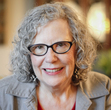N.J. Lindquist's Blog, page 3
June 28, 2020
Working on This Site
Just thought I'd mention that after two and a half weeks of working on updating this website in "staging" (aka behind the scenes), we've now gone live with it. I'm pretty sure there are some little glitches that are still hiding from me, so if you notice a link that doesn't work or an error of any kind, please do let me know.
While waiting for the theme developer to get back to me on some issues we were having, we decided to update the covers for my Circle of Friends series, so that was fun too. And I've probably missed updating those in a few places.
This is what they look like. Plus I made a box set! And, as you can see below, I've changed my free book offer to In Time of Trouble.
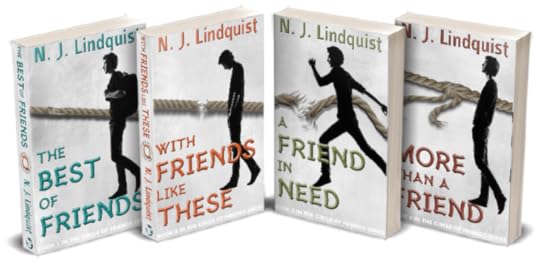
The post Working on This Site appeared first on N. J. Lindquist.
June 10, 2020
LoveChild 36: Getting to Know My Dad’s Side of Our Family
“We need extended families.… A nuclear family, a man, a woman and kids and a dog and cat is no survival scheme at all. Horribly vulnerable..”
– Kurt Vonnegut
During the summer of 1954, we celebrated my grandmother's 80th birthday with a family reunion
I've mentioned before that we saw quite a bit more of our family after we moved to Crystal City. We lived close enough to Brandon that we drive there and come back the same day. Or, because my dad's store was open from Monday to Saturday, we could drive up Saturday evening and come back Sunday evening, or go up on Sunday and come back Monday morning. Although the store was closed for lunch during the day, I'm assuming Dad had someone who worked for him part-time and could fill in as needed.
Also, while our relatives didn't visit us often, they did come on occasion.
However, during the summer of 1954, when I was six, we were able to spend several days with a large number of members of Dad's family. We were celebrating Granny Shaw's 80th birthday, and as many members of her family came together as were able. I have a feeling we spent most of the time in Brandon but also drove up to Rossburn for part of the time. That's where Grandpa Shaw and their second son, Bill, who died six months after I was born, were buried, as well as the two little girls who had died as infants. We visited that cemetery a number of times over the years.
Since I was six, I was now old enough to understand who was who and engage with them.
I assume the picture below was taken by a photographer. All eight of her living children were present.
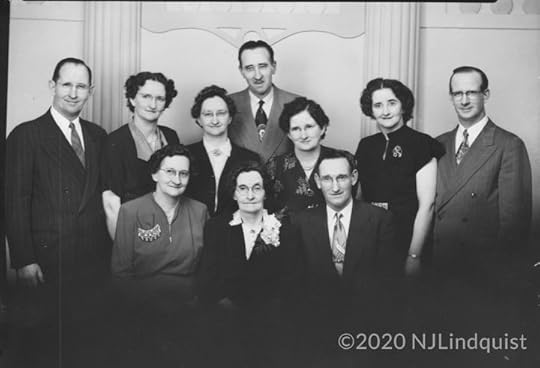
Back row from left: Lorne, Sarah, Margaret, Robert (Dad), Grace, Jean, Walter. Seated: Agnes, Granny Shaw (Jenny), George. No, my dad wasn't that much taller. He had to be standing on something.
Two more photos from that summer (sent to me by my cousin Joan).
The first is Granny Shaw with some of her children; the second is Granny Shaw with some of the spouses of her children. I have a vague feeling these pictures might have been taken in Rossburn, but I could be wrong.
Uncle Lorne and Aunt Elsie are missing, likely because they had left on the long drive back to Ohio. Linda, Bill's wife, is missing. As is Uncle Lockie, Aunt Grace's husband.
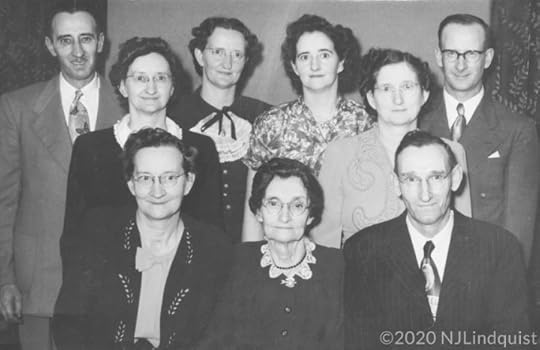
Back row: Robert (Dad), Sarah, Jean, Walter. Middle Row, Margaret, Grace. Front row: Agnes, Granny Shaw, George.
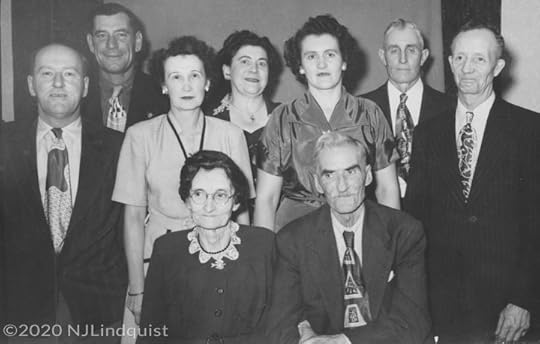
Back row: Alf Mitchell (Sarah), Mabel Shaw (George), Gordon Taylor (Agnes); Middle row: Howard Maltby (Jean), Margaret Shaw (Mom), Marguerite Shaw (Walter), Albert Roney (Margaret); Front row: Granny Shaw, her brother Jim Sherritt.
The picture below isn't a great one, but it shows me with Granny Shaw and the cousins I knew best because I saw them the most. They were all eight or so years older than me, which is a lot when you're six.
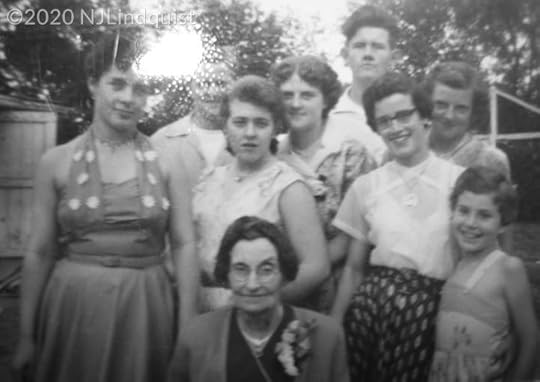
From left: Ferle, Barry?, Joan, Darlene, Garnet, Faye, Eleanor, and me.
Garnet, Ferle, Faye, and their older sister Theresa were Walter and Marguerite's children. Joan and her younger brother Barry were Howard and Jean's children. Darlene, Eleanor and their older sister Joyce were Alf and Sarah Mitchell's children.
Those closest to my age were Barry, Joan, Eleanor, and Faye.
I have a cousin my age!
I'd heard my dad talk about his brother Lorne, and I'd seen a few pictures of him and his wife Elsie and their son, but they lived far away in the United States so, in a way, they didn't feel real to me.
However, they drove up to Brandon for Granny Shaw's 80th birthday! Lyle was only four months younger than me, and I was thrilled to have a cousin the same age! Not only that, but we had a lot in common since he was also an only child.
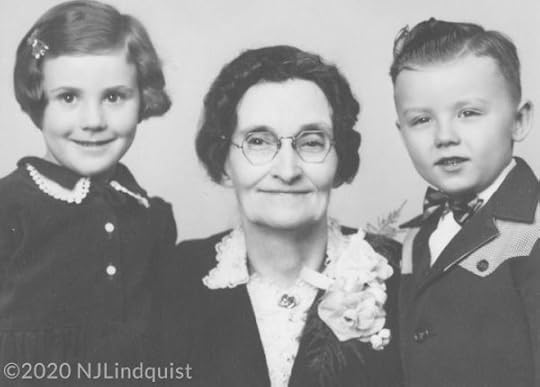
Me, Granny Shaw, and my cousin Lyle. No idea why I look a bit wild.
We were the youngest of Granny Shaw's grandchildren by quite a few years.
During the time we were there, we spent as much time together as we could.
In the first picture, Dad had taken us to the small park in Brandon to see the deer.
We went there or to other zoos whenever we had the chance, and it was often Dad who suggested it. I'm just this moment realizing that he liked animals, which was probably why he hated being a butcher and a mink farmer.
In the picture on the right, where we both look very solemn, I have no idea who the little boy with us is, or the lady (his mother?) behind us. I'm guessing she's one of my cousins or cousins-in-law.
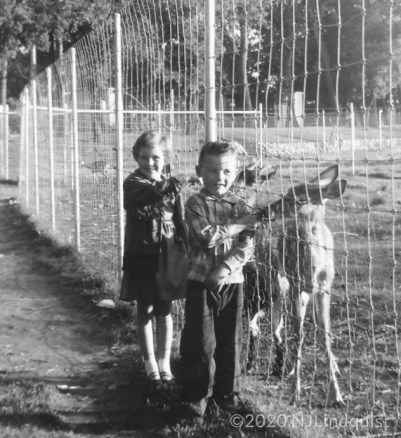
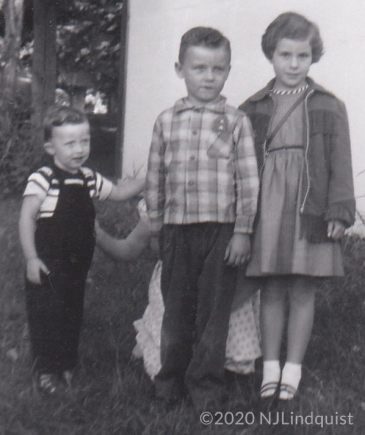
Since I was the "experienced" cousin, and we spent a lot of our time at Uncle Albert and Aunt Margaret and Granny Shaw's house, I got to show Lyle the back yard, introduce him to the Chinese checker board Uncle Albert and I used to play checkers, and got out the little plastic bread container with its different coloured Bible verses. I probably asked Aunt Margaret to let us play with some of her flannelgraph figures in their bedroom, too. (More about these things soon!)
Being Part of an Extended FamilyI mentioned earlier that it was easy to feel that my parents and I, along with Bozo and Tippy, were all alone in a new community where many people were related to each other or had lived for many years and therefore had very close friends who were like family.
I don't for one minute think anyone meant for us to feel like outsiders but, for me, it was hard not to, and I'm sure Mom felt the same.
I'm not sure about my dad. He was focused on doing his best to look after Mom and me, and of course he was busy with his store. Even though he'd been in a business before, this was a brand new venture for him. He'd never sold women's and children's clothes, and as far as I know, he had no mentor and no access to any kind of "rules of business." The only people he met who might have offered suggestions were some of the wholesale salesmen who came by, and of course, their primary goal was to get him to buy their products. Back then, it was do your best, learn what works and what doesn't, and keep trying.
I don't know about my parents but, for me, the time with our extended family that summer made me feel a lot more secure. We weren't adrift in the world alone even if it sometimes felt that way. It had been easy to see that my parents were good friends with many of the members of Dad's family, and that they were very comfortable with them. It was a bit weird that some of my parents' family friends were technically my cousins and were old enough to be my parents (at six, that's kind of hard to grasp), but all that really mattered was that we had people who cared about us.
One byproduct of that summer was that when my parents talked about this person or that from the Shaw family, I could usually picture them in my mind or at least ask an intelligent question.
Sure, we might be outsiders in Crystal City, and we might not have any family or close friends there, but we did have family! Lots and lots of family! When I felt as though we were outsiders, I knew it was just temporary and it would be okay.
And even if I never saw him again, I had a cousin my own age who I really liked!
. . .
Can You Relate?
Did you have extended family members near you when you were growing up? Or longtime family friends?
Did you ever feel like an outsider?
@media (min-width: 300px){.thrv_symbol_10531 [data-css="tve-u-1656479a734"] { width: 100px; float: none; border: 1px solid rgb(0, 0, 0); box-shadow: rgba(0, 0, 0, 0.4) 0px 8px 12px 0px; margin-left: auto !important; margin-right: auto !important; margin-top: 0px !important; }.thrv_symbol_10531 [data-css="tve-u-1656479a731"] { margin-left: 9px !important; }.thrv_symbol_10531 [data-css="tve-u-1656479a730"] { max-width: 57.4%; }.thrv_symbol_10531 [data-css="tve-u-1656479a733"] { max-width: 42.6%; }.thrv_symbol_10531 [data-css="tve-u-1656479a72f"] { max-width: 820px; float: none; width: 100%; margin-left: auto !important; margin-right: auto !important; }.thrv_symbol_10531 [data-css="tve-u-1656479a72e"] { min-height: 245px; }:not(#tve) .thrv_symbol_10531 [data-css="tve-u-1656479a734"] { width: 252px; }:not(#tve) .thrv_symbol_10531 [data-css="tve-u-1656d159d04"] { font-size: 18px !important; }:not(#tve) .thrv_symbol_10531 [data-css="tve-u-1656d159d06"] { font-size: 18px !important; }:not(#tve) .thrv_symbol_10531 [data-css="tve-u-1656d15d51d"] { max-width: 679px; float: none; width: 100%; margin-left: auto !important; margin-right: auto !important; }:not(#tve) .thrv_symbol_10531 [data-css="tve-u-1656d15d51d"] > .tve-cb { justify-content: center; display: flex; flex-direction: column; }:not(#tve) .thrv_symbol_10531 [data-css="tve-u-1656d16fbe9"] { float: none; width: 100%; margin-left: auto !important; margin-right: auto !important; }:not(#tve) .thrv_symbol_10531 [data-css="tve-u-1656d1795e1"] { font-size: 18px !important; line-height: 0.35em !important; }:not(#tve) .thrv_symbol_10531 [data-css="tve-u-1656d17bf7c"] { line-height: 0.6em !important; color: rgb(113, 30, 30) !important; }}
. . .
LoveChild: Life Lessons from an Ugly Duckling is the story of my struggle to adjust to the life I was given, and my eventual discovery that, not only had I become a swan but, contrary to my perceptions, I had always been one. Though I didn't realize it until many years later, my life was part of a much bigger plan that all made perfect sense.
I'll be blogging my story once a week.
Find links to all these blogs at:
https://www.njlindquist.com/lovechild/
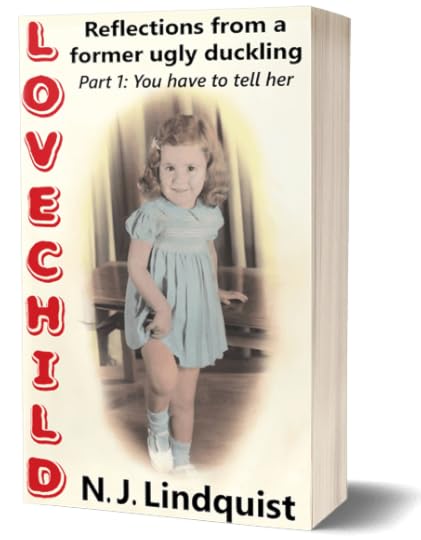
@media (min-width: 300px){.thrv_symbol_10677 [data-css="tve-u-170839f7c3e"] { max-width: 515px; float: none; border: 2px solid rgb(0, 0, 0); margin: 40px auto !important; padding-left: 40px !important; padding-right: 40px !important; }:not(#tve) .thrv_symbol_10677 [data-css="tve-u-170839f7c40"] button { background-image: none !important; background-color: rgb(113, 30, 30) !important; }} Sign Up to Have My New Memoir Posts Sent Directly to Your Inbox
The post LoveChild 36: Getting to Know My Dad’s Side of Our Family appeared first on N. J. Lindquist.
June 8, 2020
A Robins’ Nest at Our Front Door, Part 4
I discovered a robins' nest above our front door on May 5th, 2014.
If you missed the first three parts of the story, you can find them here.
On the morning of July 9th, I opened our front door to get the daily newspaper, and not one but two robins flew out of the nest above our light fixture, chattering and complaining at the top of their lungs.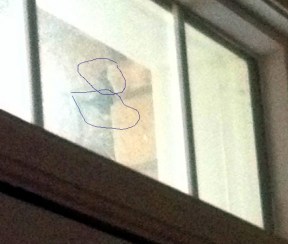
If you look closely at this picture, which I'll admit is very poor quality, you can see two adult robin heads right in the centre, against the corner of the wall of our entranceway.
Was it Mama Robin and one of her first babies? Or Mama and Papa Robin? Or Papa Robin and an older baby? I have no idea.
Why didn't someone warn me that robins typically have two, sometimes three, families each year?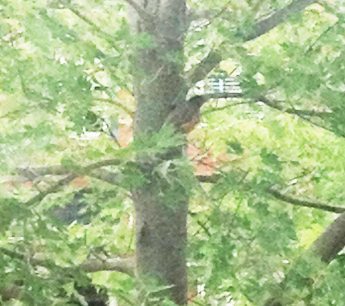
I was never able to get a decent picture but over the next days there were usually two robins in the tree out front, one bigger than the other. I assumed it was Papa Robin and one of the first babies.
These pictures were both taken on June 17th.
Meanwhile, Mama Robin was staring me down, daring me to just try to open the front door or get any closer to her and her eggs.
It's strange, but she seemed to be able to hear me even when I came down the carpeted stairs as quietly as possible and took great care in noiselessly stepped onto the little stool so I could see.
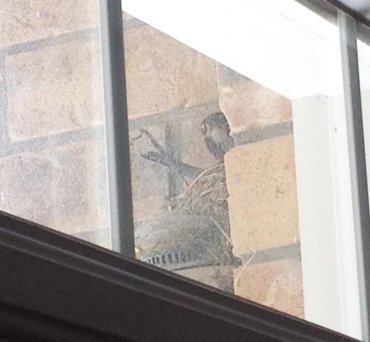
I also muted my phone so she wouldn't hear the sound of the pictures being taken, but she always knew.
Bottom line: We were going to have to delay fixing up our front entrance yet again.
Do all robins look alike or are there ways to tell one robin from another?
When I see random robins while I'm walking in or area (and we have a lot of robins), they all look alike. But our first Mama Robin definitely looked unique (and kind of frazzled) to me.
And most of the time when I looked at the robin who was hanging out now I thought they might be the same bird.
The more I saw of Mama Robin, the more I thought this was the same pair of robins who had built the nest.
What do you think?
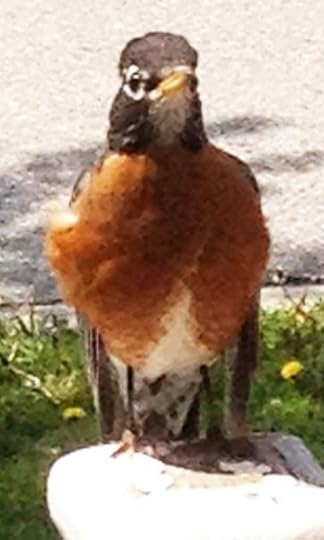
Mama Robin #1
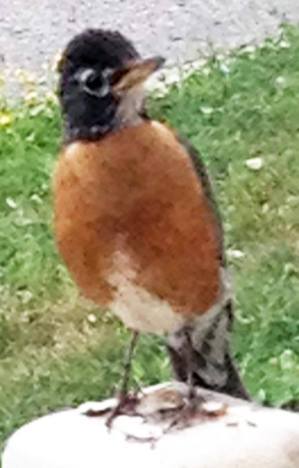
Mama Robin #2
Pictures from July 19th.
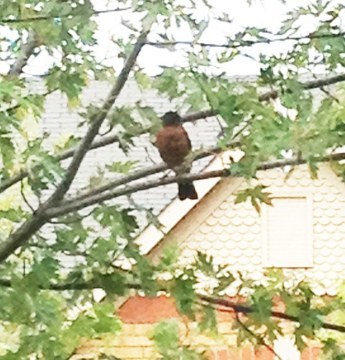
It might look as if Papa Robin was just relaxing in the sun, but he's actually on high alert, ready to chirp like mad if anything or anyone goes near the nest, and to fly off in hopes they'll follow him.
Several people coming to my house are witnesses to that.
Mama Bird looking to make sure I'm not going to endanger her babies.
She never backed down once she'd seen me.
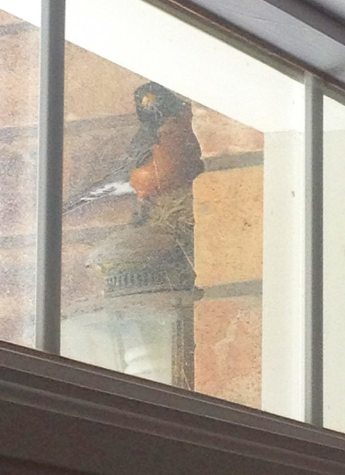

In case you missed it, I had to stand on this stool and look through the upper window on the right to see the nest.
The other pictures I took through the windows on either side of the door.
At this point, because the nest was frequently without an adult bird in it, we assumed the babies had hatched. However, we never saw even a small piece of an eggshell. The parents took them away so no predators would spot them. There were also very few bird droppings on our doorstep.
When she was on lookout duty on the post, Mama Bird was never still. She kept turning her head to look in every direction.
Except when she spotted me looking at her through the window (top row, middle picture). Then she stared until I moved away.
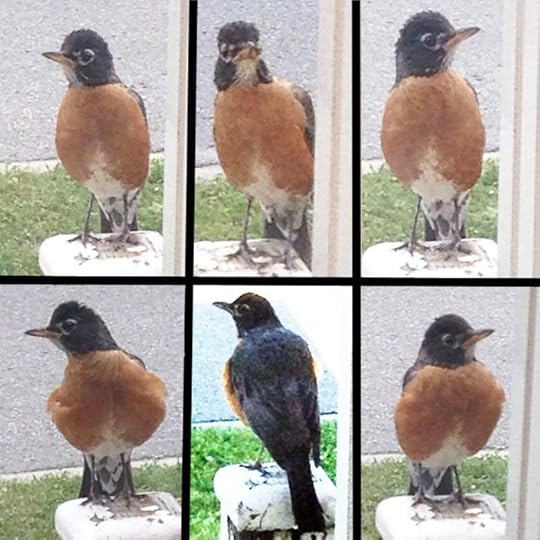
Occasionally, I saw both birds out front, but most of them time one was at the nest. So far, no little heads poking above.
July 29th
For the first time, on July 29th, I could just barely see at least two, possibly three, little beaks poking up above the nest.
I think it's Papa Robin hovering over them.
The two adults took turns bringing worms to the babies and keeping watch out front, either in a tree, on our post, on the ground, or on either our roof or that of our neighbour to the right.
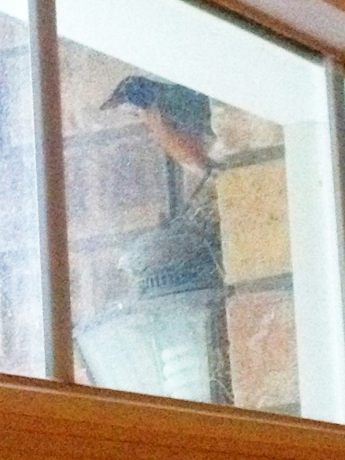
We were close to the day when the babies' heads would start to show above the nest.
To Be Continued...
The post A Robins’ Nest at Our Front Door, Part 4 appeared first on N. J. Lindquist.
June 7, 2020
White People Who Say They’re Color Blind Are Missing the Point

Photo copyright Rawpixel on Deposit Photos
People come in all different sizes, shapes, and colors. So when you say you’re going to be “color blind,” what you’re really saying is that you’re going to ignore (or try to ignore) other people’s skin color. But if you ignore people’s skin color, what else do you have to ignore? Their hair? How tall they are? The shape of their chin? The look in their eyes? It’s impossible to me to truly ignore the color of the skin of someone standing in front of me—just as it’s impossible for you to ignore the color of my skin.
If I ignore the color of your skin, I can’t see you
The obvious response is to wish we could all have the same color of skin. And at first glance, that might seem like a good idea. Except that if God had intended for us to all have same skin color, the world would have to have been made differently than it is. Because God’s making the world the way it is was one of the primary causes of the variation in skin color. We have different colors of skin because of where we live in relation to the sun, who our ancestors married, and the foods we eat.
Don’t believe me? Google it. Most of the results will be the same as this one.
If you want a “Christian” response, there’s this one.
I'd rather have 20/20 vision than be color blind.
Picture copyright monkeybusiness on Deposit Photos
What I mean by that is that when I see people—like for example the three boys above—I want to see them for who they are. I see three adorable boys. But I don’t know how it’s even possible to pretend I can ignore the color of their skin, any more than I can ignore the kind of hair they have, or the look in their eyes.
One has light beige pinkish skin and the other two have brownish skin—the boy on the left a clear medium brown and the boy on the right a slightly darker brown.
I also can’t ignore that the boy in the middle has longish blond hair, the one on the left short dark hair—almost black, and the head of the boy on the right has been shaved so his curls are hidden unless you look closely.
The question is, when we look at this picture, do we feel love for all the boys, or do we feel it for only one boy?
The key is to realize that every variation of skin color is beautifulHow could anyone look at these boys and think that one is better or more worthy than the others because of his skin color?
And yet there are people who do.
For me, the problem we’re facing has nothing to do with skin color but is about the need many people have for wealth, power, and control.
There are history books written on how people moved through the world, but the key fact for me is that the people of Europe, in particular those of the England, Spain, France, Belgium, and the Netherlands became so strong that they were able to move out to other continents, invading and conquering the Indigenous people who were already there. It happened in North and South America, in Africa, Australia, India, and many smaller nations.
And because the invading nations were powerful, with advanced weapons and organization, they ruled with an iron fist, and many of the people who lived in those nations died, either during the conquest or from smallpox and other diseases their conquerors brought with them.
Of those remaining, many were forced to be slaves or servants, and others were forced to move to areas where the land wasn’t as good and they were often mistreated.
What does all that have to do with skin color?Just this. Since the conquering forces were all shades of one color—what we call “white”—and the people conquered were of darker “not white” colors, it became almost automatic for the darker-skinned people to be seen as lesser. So the emboldened conquerors used their victories to denigrate those people and treat them as if they were lesser humans.
In my view, the resulting slavery and poverty were caused primarly by two things: the lust for power, and the belief that some people are worth more than others and therefore ought to be the rulers.
White supremacy is simply a desire to contnue to be the conquerors
Pretending to be color blind ignores the reality that the people who are racist are doing their best to keep people of other colors from being seen as equals.
What we are seeing right now in the US is a struggle between the white people who want to continue to be the conquerors and to rule everyone else against the people of every other color (even many white people) who have been trying for many years to create true equality where everyone is seen as having the same value and the same rights.
Many of us, and I include myself here, grew up without even realizing that by being born white, we automatically had privileges that the rest of the people didn’t have—would never have. Even the wealthiest Black person or the most famous Black athlete or actor or musician is still in danger of being seen only by their color. There are individuals and even police who are willing, even eager, to kill a Black person simply because of the color of their skin.
I was reminded recently of a song I sang long ago in Sunday school.I'm sure most of us know it.
Jesus loves the little children,
All the children of the world;
Red and yellow, black and white,
All are precious in His sight,
Jesus loves the little children of the world.
Lyrics by George F. Root
On one level, I don’t have a problem with the song because it’s 100% true. Jesus does love all the children of the world. He loves all the adults, too. The good ones and the bad ones. Every. Single. One.
But on another level, I have a serious problem with the song.
I’m pretty sure that when we sang it in Sunday school or church, we were thinking about darker-skinned people in what we call third-world countries (countries the white skinned people did a lot to destroy). We were thinking of people who had come to rely on the help of white missionaries, shoe boxes with trinkets at Christmas, or monthly monetary gifts to help them have enough food or to get any sort of education. And while I’m not implying that the desire to help people is a bad thing, I am saying that it was very easy for us to feel superior while we were singing this song or donating to missions.
We’re not nearly as comfortable with the darker-skinned people living in the house next door, sending their children to “our” schools, getting equal pay to work in the same company as us, or—horrors!—being promoted to be our managers.
The truth is, far too many people who sang that song as children grew up with a mindset that implied it was okay to treat people with different-colored skin as if they weren’t equal to us. We wanted them to stay in their place.
Honestly, we’ve often treated them as if we thought God didn’t love them as much as he did us. As if they ought to be satisfied with having a place to live and enough food to eat, and if they didn’t make something of themselves, it was because they must be lazy. Worse, we’ve thrown many of them in jail for minor offences and carded and targeted them, and acted as if they should be content with whatever scraps we give them.
It’s as if we actually believed that even God loves people with light skin more than those with darker skin.
Do you look at these kids and believe that each of them should be able to grow up to be anything they want?
Picture copyright monkeybusiness on Deposit Photos
God does. Each child, regardless of skin color, was created with particular skills and open-ended possibilities. But how many people have never had the opportunity of becoming all they were meant to be because of the rules and boundaries created by white individuals or groups who chose to exert their power to keep everyone else from having what they have?
When the world was created, God designed it in such a way that the various skin colors would appear depending on which part of the world we lived in. This wasn’t an accident. The colors were always part of us.
I think this is a test. And if so, many of us are failing!Jesus said this.
Not all those who say ‘You are our Lord’ will enter the kingdom of heaven. The only people who will enter the kingdom of heaven are those who do what my Father in heaven wants. (Matthew 7:21, NCV)
And what does the Father in Heaven want?
Jesus said to all of them, “If people want to follow me, they must give up the things they want. They must be willing to give up their lives daily to follow me.” (Luke 9:23, NCV)
I give you a new command: Love each other. You must love each other as I have loved you. All people will know that you are my followers if you love each other.
(John 13:34–35, NCV)
Jesus answered, “‘Love the Lord your God with all your heart, all your soul, and all your mind.’ This is the first and most important command. And the second command is like the first: ‘Love your neighbor as you love yourself.’ All the law and the writings of the prophets depend on these two commands.”
(Matthew 22:37–40, NCV)
Maybe I’m wrong, but it seems pretty simple to me. God wants our lives to be filled with love: love for God, love for ourselves, and love for one other.
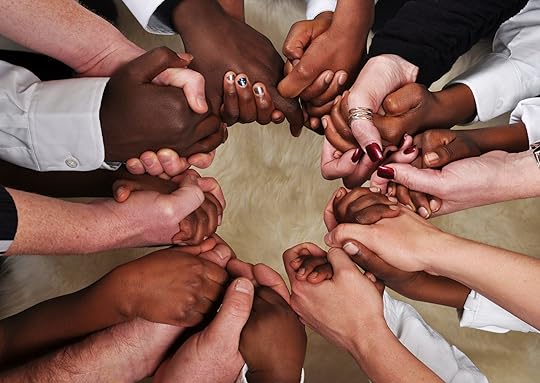
Photo copyright Brett Jorgensen on Shutterstock
All skin colors are tones of the same color
Jesus loves all of us exactly the same. Every white person. Every black person. Every brown person…. Every single one. And he wants us to treat each other with love. This is not something conquerors do. So we need to put that mindset away.
Those of us who call ourselves by the name of Christ need to think hard and long about what is most important: being seen as conquerors or being the kind of people who try hard to love everyone.
I would add that just as each snowflake is unique, so each person is unique. Just as all white-skinned people aren’t alike, neither are all darker-skinned people people. We need to help each person become the best individual they can be.
Jesus loves the little children
All the children of the world
Red, brown, yellow, black and white
They are precious in His sight
Jesus loves the little children of the world
Jesus died for all the children
All the children of the world
Red, brown, yellow, black and white
They are precious in His sight
Jesus died for all the children of the world.
Jesus loves the little children
All the children of the world
Red, brown, yellow, black and white
They are precious in His sight
Jesus loves the little children of the world
Revised version by Donna J. Krieger, George F. Root
He’d have been in the middle of the skin tone spectrum.
Researchers say he’d have looked something like the picture below. His disciples were likely similar in appearance.
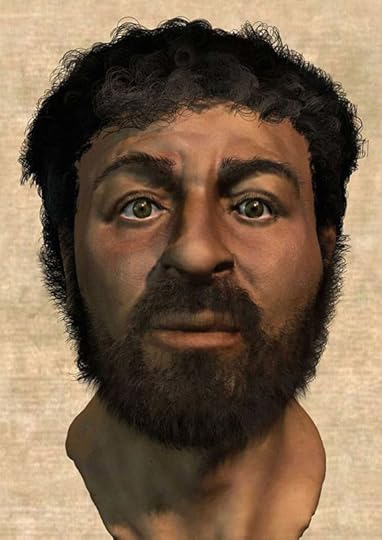
Using forensic techniques, retired medical artist Richard Neave has recreated the face of Jesus (pictured). Photo Credit: BBC/Red Vision.
Instead of being color blind, we need to be color aware.Those of us are white need to need to recognize the privilege we have simply by being born with the color of skin we have. And we need to recognize that every color of skin is beautiful, and was part of God’s plan.
And we need to do all that we can to protect people of darker skin tones from those who still want to be seen as conquerors, whether they are individuals, police officers, or elected officials.
We need to show our children and communities how Christ-followers act.
What if we don’t feel love for people with darker skins?We need to act as if we do.
I used to teach a training class for Sunday school teachers, and I know that almost every class has a child or even a couple of children that are really hard to like. But what I told the teachers is that our job isn’t to like them; our job is to act in love toward them.
And it works!
Sure, sometimes it’s hard. But the funny thing is that when you act as if you love someone, you often end up not only loving them but liking them, too.
Love is an action, not an emotion.
No one said loving others is easy. But it’s what we’re supposed to be doing. Even if we start by acting in love toward one person who might not be easy for us to love, it’s a beginning.
The post White People Who Say They’re Color Blind Are Missing the Point appeared first on N. J. Lindquist.
I Choose Not to Be Color Blind

Photo copyright Rawpixel on Deposit Photos
Recently I’ve heard people say that they’re color blind, or that we should all be color blind. But I disagree.People come in all different sizes, shapes, and colors. So when you say you’re going to be “color blind,” what you’re really saying is that you’re going to try to ignore people’s skin color. But if you ignore people’s skin color, what else do you have to ignore? Their hair? How tall they are? The shape of their chin? The look in their eyes? It’s impossible to me to truly ignore the color of the skin of someone standing in front of me—just as it’s impossible for you to ignore the color of my skin.
If I ignore the color of your skin, I can’t see you
The obvious response is to wish we could all have the same color of skin. And at first glance, that might seem like a good idea. Except that if God had intended for us to all have same skin color, the world would have to have been made differently than it is. Because God’s making the world the way it is was one of the primary causes of the variation in skin color. We have different colors of skin because of where we live in relation to the sun, who our ancestors married, and the foods we eat.
Don’t believe me? Google it. Most of the results will be the same as this one.
If you want a “Christian” response, there’s this one.
I'd rather have 20/20 vision than be color blind.
Picture copyright monkeybusiness on Deposit Photos
What I mean by that is that when I see people—like for example the three boys above—I want to see them for who they are. I see three adorable boys. But I don’t know how it’s even possible to pretend I can ignore the color of their skin, any more than I can ignore the kind of hair they have, or the look in their eyes.
One has light beige pinkish skin and the other two have brownish skin—the boy on the left a clear medium brown and the boy on the right a slightly darker brown.
I also can’t ignore that the boy in the middle has longish blond hair, the one on the left short dark hair—almost black, and the head of the boy on the right has been shaved so his curls are hidden unless you look closely.
The question is, when we look at this picture, do we feel love for all the boys, or do we feel it for only one boy?
The key is to realize that every variation of skin color is beautifulHow could anyone look at these boys and think that one is better or more worthy than the others because of his skin color?
And yet there are people who do.
For me, the problem we’re facing has nothing to do with skin color but is about the need many people have for wealth, power, and control.
There are history books written on how people moved through the world, but the key fact for me is that the people of Europe, in particular those of the England, Spain, France, Belgium, and the Netherlands became so strong that they were able to move out to other continents, invading and conquering the Indigenous people who were already there. It happened in North and South America, in Africa, Australia, India, and many smaller nations.
And because the invading nations were powerful, with advanced weapons and organization, they ruled with an iron fist, and many of the people who lived in those nations died, either during the conquest or from smallpox and other diseases their conquerors brought with them.
Of those remaining, many were forced to be slaves or servants, and others were forced to move to areas where the land wasn’t as good and they were often mistreated.
What does all that have to do with skin color?Just this. Since the conquering forces were all shades of one color—what we call “white”—and the people conquered were of darker “not white” colors, it became almost automatic for the darker-skinned people to be seen as lesser. So the emboldened conquerors used their victories to denigrate those people and treat them as if they were lesser humans.
In my view, the resulting slavery and poverty were caused primarly by two things: the lust for power, and the belief that some people are worth more than others and therefore ought to be the rulers.
White supremacy is simply a desire to remain as the conquerors
Pretending to be color blind ignores the reality that the people who are racist are doing their best to keep people of other colors from being seen as equals.
What we are seeing right now in the US is a struggle between the white people who want to continue to be the conquerors and to rule everyone else against the people of every other color (even many white people) who have been trying for many years to create true equality where everyone is seen as having the same value and the same rights.
Many of us, and I include myself here, grew up without even realizing that by being born white, we automatically had privileges that the rest of the people didn’t have—would never have. Even the wealthiest Black person or the most famous Black athlete or actor or musician is still in danger of being seen only by their color. There are individuals and even police who are willing, even eager, to kill a Black person simply because of the color of their skin.
I was reminded recently of a song I sang long ago in Sunday school.I'm sure most of us know it.
Jesus loves the little children,
All the children of the world;
Red and yellow, black and white,
All are precious in His sight,
Jesus loves the little children of the world.
Lyrics by George F. Root
On one level, I don’t have a problem with the song because it’s 100% true. Jesus does love all the children of the world. He loves all the adults, too. The good ones and the bad ones. Every. Single. One.
But on another level, I have a serious problem with the song.
I’m pretty sure that when we sang it in Sunday school or church, we were thinking about darker-skinned people in what we call third-world countries (countries the white skinned people did a lot to destroy). We were thinking of people who had come to rely on the help of white missionaries, shoe boxes with trinkets at Christmas, or monthly monetary gifts to help them have enough food or to get any sort of education. And while I’m not implying that the desire to help people is a bad thing, I am saying that it was very easy for us to feel superior while we were singing this song or donating to missions.
We’re not nearly as comfortable with the darker-skinned people living in the house next door, sending their children to “our” schools, getting equal pay to work in the same company as us, or—horrors!—being promoted to be our managers.
The truth is, far too many people who sang that song as children grew up with a mindset that implied it was okay to treat people with different-colored skin as if they weren’t equal to us. We wanted them to stay in their place.
Honestly, we’ve often treated them as if we thought God didn’t love them as much as he did us. As if they ought to be satisfied with having a place to live and enough food to eat, and if they didn’t make something of themselves, it was because they must be lazy. Worse, we’ve thrown many of them in jail for minor offences and carded and targeted them, and acted as if they should be content with whatever scraps we give them.
It’s as if we actually believed that even God loves people with light skin more than those with darker skin.
Do you look at these kids and believe that each of them should be able to grow up to be anything they want?
Picture copyright monkeybusiness on Deposit Photos
God does. Each child, regardless of skin color, was created with particular skills and open-ended possibilities. But how many people have never had the opportunity of becoming all they were meant to be because of the rules and boundaries created by white individuals or groups who chose to exert their power to keep everyone else from having what they have?
When the world was created, God designed it in such a way that the various skin colors would appear depending on which part of the world we lived in. This wasn’t an accident. The colors were always part of us.
I think this is a test. And if so, many of us are failing!Jesus said this.
Not all those who say ‘You are our Lord’ will enter the kingdom of heaven. The only people who will enter the kingdom of heaven are those who do what my Father in heaven wants. (Matthew 7:21, NCV)
And what does the Father in Heaven want?
Jesus said to all of them, “If people want to follow me, they must give up the things they want. They must be willing to give up their lives daily to follow me.” (Luke 9:23, NCV)
I give you a new command: Love each other. You must love each other as I have loved you. All people will know that you are my followers if you love each other.
(John 13:34–35, NCV)
Jesus answered, “‘Love the Lord your God with all your heart, all your soul, and all your mind.’ This is the first and most important command. And the second command is like the first: ‘Love your neighbor as you love yourself.’ All the law and the writings of the prophets depend on these two commands.”
(Matthew 22:37–40, NCV)
Maybe I’m wrong, but it seems pretty simple to me. God wants our lives to be filled with love: love for God, love for ourselves, and love for one other.
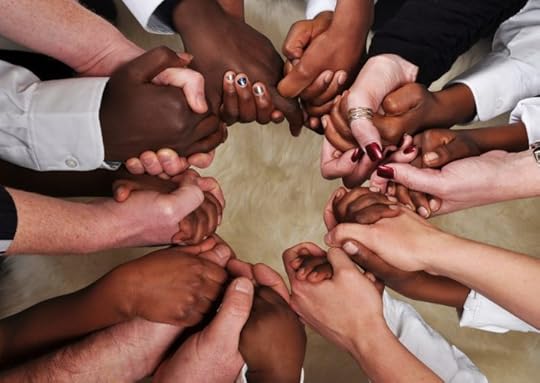
Photo copyright Brett Jorgensen on Shutterstock
All skin colors are tones of the same color
Jesus loves all of us exactly the same. Every white person. Every black person. Every brown person…. Every single one. And he wants us to treat each other with love. This is not something conquerors do. So we need to put that mindset away.
Those of us who call ourselves by the name of Christ need to think hard and long about what is most important: being seen as conquerors or being the kind of people who try hard to love everyone.
I would add that just as each snowflake is unique, so each person is unique. Just as all white-skinned people aren’t alike, neither are all darker-skinned people people. We need to help each person become the best “them” they can be.
Jesus loves the little children
All the children of the world
Red, brown, yellow, black and white
They are precious in His sight
Jesus loves the little children of the world
Jesus died for all the children
All the children of the world
Red, brown, yellow, black and white
They are precious in His sight
Jesus died for all the children of the world.
Jesus loves the little children
All the children of the world
Red, brown, yellow, black and white
They are precious in His sight
Jesus loves the little children of the world
Revised version by Donna J. Krieger, George F. Root
He’d have been in the middle of the skin tone spectrum.
Researchers say he’d have looked something like the picture below. His disciples were likely similar in appearance.
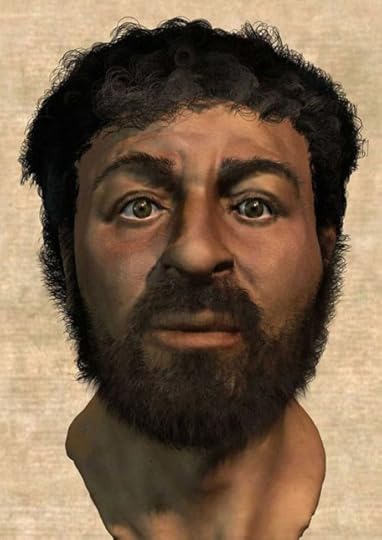
Using forensic techniques, retired medical artist Richard Neave has recreated the face of Jesus (pictured). Photo Credit: BBC/Red Vision.
Instead of being color blind, we need to be color aware.Those of us are white need to need to recognize the privilege we have simply by being born with the color of skin we have. And we need to recognize that every color of skin is beautiful, and was part of God’s plan.
And we need to do all that we can to protect people of darker skin tones from those who still want to be seen as conquerors, whether they are individuals, police officers, or elected officials.
We need to show our children and communities how Christ-followers act.
What if we don’t feel love for people with darker skins?We need to act as if we do.
I used to teach a training class for Sunday school teachers, and I know that almost every class has a child or even a couple of children that are really hard to like. But what I told the teachers is that our job isn’t to like them; it’s our job to act in love toward them.
And it works!
Sure, sometimes it’s hard. But the funny thing is that when you act as if you loved someone, you often end up not only loving them but liking them, too.
Love is an action, not an emotion.
No one said loving others is easy. But it’s what we’re supposed to be doing. Even if we start by acting in love toward one person who might not be easy for us to love, it’s a beginning. And it’s what we should all be doing.
The post I Choose Not to Be Color Blind appeared first on N. J. Lindquist.
Let’s Choose Not to Be Color Blind

Photo copyright Rawpixel on Deposit Photos
Recently I’ve heard people say that they’re color blind, or that we should all be color blind. But I disagree.People come in all different sizes, shapes, and colors. So when you say you’re going to be “color blind,” what you’re really saying is that you’re going to try to ignore people’s skin color. But if you ignore people’s skin color, what else do you have to ignore? Their hair? How tall they are? The shape of their chin? The look in their eyes? It’s impossible to me to truly ignore the color of the skin of someone standing in front of me—just as it’s impossible for you to ignore the color of my skin.
If I ignore the color of your skin, I can’t see you
The obvious response is to wish we could all have the same color of skin. And at first glance, that might seem like a good idea. Except that if God had intended for us to all have same skin color, the world would have to have been made differently than it is. Because God’s making the world the way it is was one of the primary causes of the variation in skin color. We have different colors of skin because of where we live in relation to the sun, who our ancestors married, and the foods we eat.
Don’t believe me? Google it. Most of the results will be the same as this one.
If you want a “Christian” response, there’s this one.
I'd rather have 20/20 vision than be color blind.
Picture copyright monkeybusiness on Deposit Photos
What I mean by that is that when I see people—like for example the three boys above—I want to see them for who they are. I see three adorable boys. But I don’t know how it’s even possible to pretend I can ignore the color of their skin, any more than I can ignore the kind of hair they have, or the look in their eyes.
One has light beige pinkish skin and the other two have brownish skin—the boy on the left a clear medium brown and the boy on the right a slightly darker brown.
I also can’t ignore that the boy in the middle has longish blond hair, the one on the left short dark hair—almost black, and the head of the boy on the right has been shaved so his curls are hidden unless you look closely.
The question is, when we look at this picture, do we feel love for all the boys, or do we feel it for only one boy?
The key is to realize that every variation of skin color is beautifulHow could anyone look at these boys and think that one is better or more worthy than the others because of his skin color?
And yet there are people who do.
For me, the problem we’re facing has nothing to do with skin color but is about the need many people have for wealth, power, and control.
There are history books written on how people moved through the world, but the key fact for me is that the people of Europe, in particular those of the England, Spain, France, Belgium, and the Netherlands became so strong that they were able to move out to other continents, invading and conquering the Indigenous people who were already there. It happened in North and South America, in Africa, Australia, India, and many smaller nations.
And because the invading nations were powerful, with advanced weapons and organization, they ruled with an iron fist, and many of the people who lived in those nations died, either during the conquest or from smallpox and other diseases their conquerors brought with them.
Of those remaining, many were forced to be slaves or servants, and others were forced to move to areas where the land wasn’t as good and they were often mistreated.
What does all that have to do with skin color?Just this. Since the conquering forces were all shades of one color—what we call “white”—and the people conquered were of darker “not white” colors, it became almost automatic for the darker-skinned people to be seen as lesser. So the emboldened conquerors used their victories to denigrate those people and treat them as if they were lesser humans.
In my view, the resulting slavery and poverty were caused primarly by two things: the lust for power, and the belief that some people are worth more than others and therefore ought to be the rulers.
White supremacy is simply a desire to remain as the conquerors
Pretending to be color blind ignores the reality that the people who are racist are doing their best to keep people of other colors from being seen as equals.
What we are seeing right now in the US is a struggle between the white people who want to continue to be the conquerors and to rule everyone else against the people of every other color (even many white people) who have been trying for many years to create true equality where everyone is seen as having the same value and the same rights.
Many of us, and I include myself here, grew up without even realizing that by being born white, we automatically had privileges that the rest of the people didn’t have—would never have. Even the wealthiest Black person or the most famous Black athlete or actor or musician is still in danger of being seen only by their color. There are individuals and even police who are willing, even eager, to kill a Black person simply because of the color of their skin.
I was reminded recently of a song I sang long ago in Sunday school.I'm sure most of us know it.
Jesus loves the little children,
All the children of the world;
Red and yellow, black and white,
All are precious in His sight,
Jesus loves the little children of the world.
Lyrics by George F. Root
On one level, I don’t have a problem with the song because it’s 100% true. Jesus does love all the children of the world. He loves all the adults, too. The good ones and the bad ones. Every. Single. One.
But on another level, I have a serious problem with the song.
I’m pretty sure that when we sang it in Sunday school or church, we were thinking about darker-skinned people in what we call third-world countries (countries the white skinned people did a lot to destroy). We were thinking of people who had come to rely on the help of white missionaries, shoe boxes with trinkets at Christmas, or monthly monetary gifts to help them have enough food or to get any sort of education. And while I’m not implying that the desire to help people is a bad thing, I am saying that it was very easy for us to feel superior while we were singing this song or donating to missions.
We’re not nearly as comfortable with the darker-skinned people living in the house next door, sending their children to “our” schools, getting equal pay to work in the same company as us, or—horrors!—being promoted to be our managers.
The truth is, far too many people who sang that song as children grew up with a mindset that implied it was okay to treat people with different-colored skin as if they weren’t equal to us. We wanted them to stay in their place.
Honestly, we’ve often treated them as if we thought God didn’t love them as much as he did us. As if they ought to be satisfied with having a place to live and enough food to eat, and if they didn’t make something of themselves, it was because they must be lazy. Worse, we’ve thrown many of them in jail for minor offences and carded and targeted them, and acted as if they should be content with whatever scraps we give them.
It’s as if we actually believed that even God loves people with light skin more than those with darker skin.
Do you look at these kids and believe that each of them should be able to grow up to be anything they want?
Picture copyright monkeybusiness on Deposit Photos
God does. Each child, regardless of skin color, was created with particular skills and open-ended possibilities. But how many people have never had the opportunity of becoming all they were meant to be because of the rules and boundaries created by white individuals or groups who chose to exert their power to keep everyone else from having what they have?
When the world was created, God designed it in such a way that the various skin colors would appear depending on which part of the world we lived in. This wasn’t an accident. The colors were always part of us.
I think this is a test. And if so, many of us are failing!Jesus said this.
Not all those who say ‘You are our Lord’ will enter the kingdom of heaven. The only people who will enter the kingdom of heaven are those who do what my Father in heaven wants. (Matthew 7:21, NCV)
And what does the Father in Heaven want?
Jesus said to all of them, “If people want to follow me, they must give up the things they want. They must be willing to give up their lives daily to follow me.” (Luke 9:23, NCV)
I give you a new command: Love each other. You must love each other as I have loved you. All people will know that you are my followers if you love each other.
(John 13:34–35, NCV)
Jesus answered, “‘Love the Lord your God with all your heart, all your soul, and all your mind.’ This is the first and most important command. And the second command is like the first: ‘Love your neighbor as you love yourself.’ All the law and the writings of the prophets depend on these two commands.”
(Matthew 22:37–40, NCV)
Maybe I’m wrong, but it seems pretty simple to me. God wants our lives to be filled with love: love for God, love for ourselves, and love for one other.

Photo copyright Brett Jorgensen on Shutterstock
All skin colors are tones of the same color
Jesus loves all of us exactly the same. Every white person. Every black person. Every brown person…. Every single one. And he wants us to treat each other with love. This is not something conquerors do. So we need to put that mindset away.
Those of us who call ourselves by the name of Christ need to think hard and long about what is most important: being seen as conquerors or being the kind of people who try hard to love everyone.
I would add that just as each snowflake is unique, so each person is unique. Just as all white-skinned people aren’t alike, neither are all darker-skinned people people. We need to help each person become the best “them” they can be.
Jesus loves the little children
All the children of the world
Red, brown, yellow, black and white
They are precious in His sight
Jesus loves the little children of the world
Jesus died for all the children
All the children of the world
Red, brown, yellow, black and white
They are precious in His sight
Jesus died for all the children of the world.
Jesus loves the little children
All the children of the world
Red, brown, yellow, black and white
They are precious in His sight
Jesus loves the little children of the world
Revised version by Donna J. Krieger, George F. Root
He’d have been in the middle of the skin tone spectrum.
Researchers say he’d have looked something like the picture below. His disciples were likely similar in appearance.

Using forensic techniques, retired medical artist Richard Neave has recreated the face of Jesus (pictured). Photo Credit: BBC/Red Vision.
Instead of being color blind, we need to be color aware.Those of us are white need to need to recognize the privilege we have simply by being born with the color of skin we have. And we need to recognize that every color of skin is beautiful, and was part of God’s plan.
And we need to do all that we can to protect people of darker skin tones from those who still want to be seen as conquerors, whether they are individuals, police officers, or elected officials.
We need to show our children and communities how Christ-followers act.
What if we don’t feel love for people with darker skins?We need to act as if we do.
I used to teach a training class for Sunday school teachers, and I know that almost every class has a child or even a couple of children that are really hard to like. But what I told the teachers is that our job isn’t to like them; it’s our job to act in love toward them.
And it works!
Sure, sometimes it’s hard. But the funny thing is that when you act as if you loved someone, you often end up not only loving them but liking them, too.
Love is an action, not an emotion.
No one said loving others is easy. But it’s what we’re supposed to be doing. Even if we start by acting in love toward one person who might not be easy for us to love, it’s a beginning. And it’s what we should all be doing.
The post Let’s Choose Not to Be Color Blind appeared first on N. J. Lindquist.
June 3, 2020
LoveChild 35: My Life Becomes More Interesting
“What we want is to see the child in pursuit of knowledge, and not knowledge in pursuit of the child."
– George Bernard Shaw
More From the Year I Was Six
I need to make it clear that most of the things I'm posting from the past are things Mom saved (and that survived various moves and a couple of unhappy events, primarily an attack by moths and a basement flood (will detail them later). Obviously, the things she kept meant something to her.
The fact that I've kept them is due to the fact that I find it hard to give or throw away things that have memories attached. Which turned out to be a good thing when I decided to write a memoir. (Why do I feel I need a smiley face here?)
So, we come to the certificate below, which shows that I graduated from Baby Band to Mission Band at the United Church in Crystal City on June 14, 1954.
Four thoughts:
1. I find it really odd that they kept us in the "Baby" Band until we were six. I'm sure I didn't realize that's what it was called or I'd have been highly offended. Did they really think we were still babies? I doubt if anything much changed with the new group, except that I and the other children who were my age were now the youngest instead of the oldest.
2. I don't have any specific memories about what we did or the leaders, but I assume it must have made an impact on me. I loved learning and doing new things, so that would have been a plus. I do know I was always happy to go.
3. What I find interesting, and rather appropriate, is the photo of children of a variety of ethnicities. We are all one race—the human race. And we ought to play and work together in harmony as this picture suggests.
The picture reminds me of a song I've sung many times. No doubt you know it, too. It was written long before I was born.
Jesus loves the little children,
all the children of the world,
red and yellow, black and white,
they are precious in his sight,
Jesus loves the little children of the world.
Lyrics by Clare Herbert Woolston; tune by George Frederick Root.
4. At the same time, I find it horrifying that the so-called Sixties Scoop, in which more than 20,000 babies and young children of First Nation, Métis, or Inuit families were forcibly taken from their homes and parents and either given to white families to be adopted or put in abusive Residential homes, actually began in 1951. And the United Church was one of the groups that participated in this. In fact, there was a United Church residential school in Brandon, where my grandmother and several of my aunts and uncles lived.
Of course, I wasn't aware of any of this then. I lived in a small town—really a village, where everyone was white.
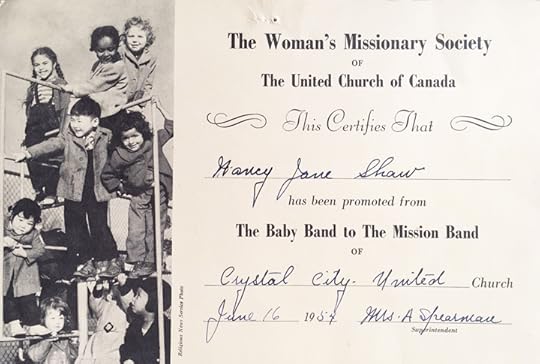
A Reminder That We Had an Extended Family
My mother's sister Brucie gave birth to a daughter, who became my cousin. In this picture, we had driven to Winnipeg, and stayed at my aunt and uncle's house in Charleswood.
I had a lot of cousins, especially on my dad's side, but most of them were quite a bit older than me. Although six years younger, Shelley was the closest female cousin to my age.
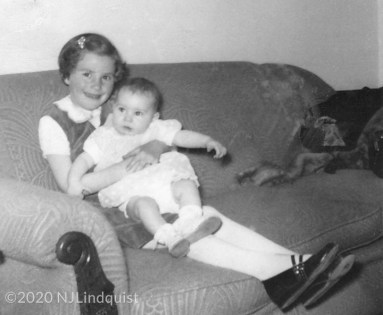
Meeting my cousin Shelley for the first time.
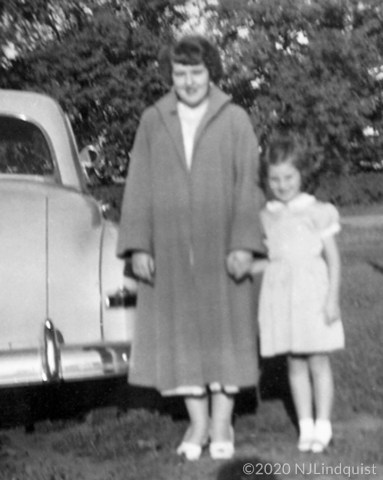
My cousin Joan, me, and Dad's new car.
Speaking of cousins, this is me with my cousin Joan, who was my dad's younger sister Jean's daughter. She and her dad and mom had come to visit us in Crystal City.
Although Joan is roughly ten years older than me, we still stay in touch and she gave me a few pictures, including this one.
There were a few other female cousins in my dad's family who are or were around Joan's age. I'll post a few more pictures of them later.
I should probably mention that I loved any chance we had to get together with members of Mom's or Dad's extended families. Many of the kids I knew in Crystal City had extended families who lived in the area. Some even had cousins who were in the same church or the same grade at school. But my family—the three of us—were newcomers to the town, and we had no roots there, so in a way we didn't quite belong.
And yes, even at six, I realized that we were somewhat different because we were new to the town and we had no relatives living close by.
Being with Mom's or Dad's families, even though it was infrequent, reassured me that the three of us weren't all alone in the world the way it sometimes felt.
I Start SchoolI wish I had a memory of my first day at school, but I don't. For me, it was a simple matter of walking across the road and entering the building, so that made it easy. I'd been watching kids go in and out of the school for two years and of course I wanted to see for myself what happened.
I know that Mom was sad and happy at the same time. I was growing up and I'd be gone all day, so she'd be alone except for Bozo and Tippy. At the same time, she knew I needed to be with the other kids and to be learning.
Since Dad only had grade 8 and Mom grade 10, they weren't that well educated and I'm sure they were somewhat concerned for me. But they knew I was a fast learner, and I expect Mom was somewhat relieved that I'd have someone else to talk to when I had questions she couldn't answer.
I was in a split grade 1/2 class, and I already knew many of the kids from living nearby, going to the same church, or because their parents knew my parents. Dad in particular got to know a lot of people because of the store.
The teacher was Miss Gilbert. She was an older woman. I believe her hair was white, and she'd been teaching for quite a while. Of course, when I say older, I'm thinking sixties or seventies, but she was likely in her late forties or early fifties. Many of my teachers seem to have been much younger than I thought they were.
And yes, Mom kept a picture of the grade 1s. I debated whether or not to post it, but I decided that I would because for all I know, my mother is the only one who kept a copy and someone out there might like to see it. Mom also wrote almost all of the names on the back. I don't remember everyone but I do remember most, in particular Louise, Diane, Barbara, Judy, Margaret, Guy, Royden, and Ian. I do have a picture of my teacher, and I'll post it in a couple of weeks when I get to grade 2.
Yes, I'm in the back row on the right. I'm a little baffled, because I always thought the girls had uniforms, but only Louise and I are wearing them. So did we have uniforms or not? Maybe we didn't have to wear them on picture day, or maybe it was a choice? It sure looks like a uniform.
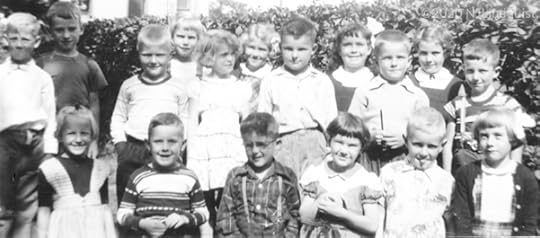 What Do I Remember About School That Year?
What Do I Remember About School That Year?Dick and Jane and Sally and Spot and Puff. Those were the characters (boy, girl, dog, cat) in our primary readers. When I got a new book, I took it home with me and sat at the dining room table with Mom or Dad or both and excitedly read the book over and over and over until I basically had it memorized.... Seriously, I could already read when I went to school, but I was so thrilled to have something new to read that I couldn't get enough.
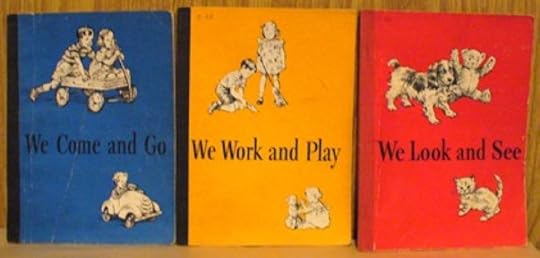
Click on the books to see more.
Christmas, 1954
I'll close with Christmas that year because Mom kept two Christmas cards that were both for me.
The first is from Granny Shaw. It's funny because Mom and Dad always referred to her as "Granny Shaw" (except when Dad called her Mother), but I see that she signed my card "Grandma Shaw."
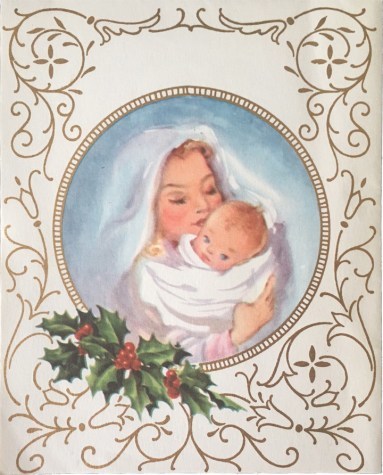
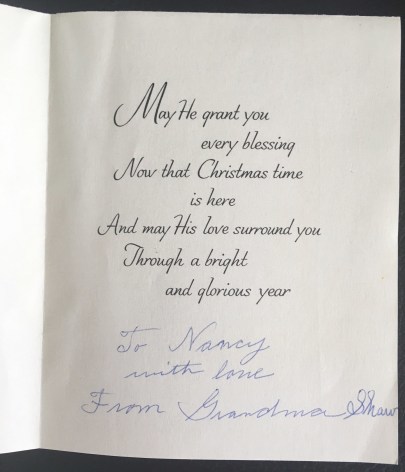
The second card is from Mom and Dad. Of course, Mom signed it. She always wrote the letters and signed things.
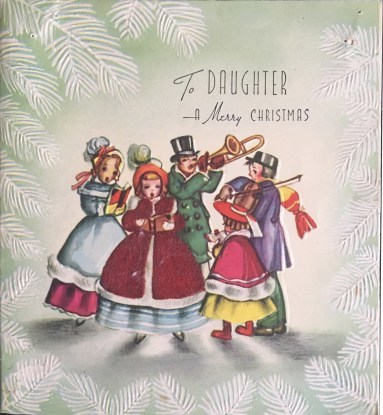 [image error]One Last Thing
[image error]One Last ThingFor Christmas that year, someone gave me a copy of Little Women that was published in 1951. I think it was Granny Shaw, but normally she signed my books and this one isn't signed. However, I can't think who else would have given it to me, and she later gave me a copy of Little Men.
In any case, it became one of my most prizes possessions. I have no idea how many times I've read it, but let's just say I lost count years ago.
Yes, it's pretty well falling apart, but I still love that cover and the pictures inside.
And in case you're wondering, I completely identified with Jo.
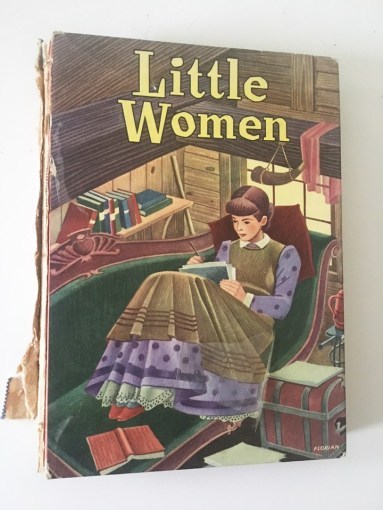
. . .
Can You Relate?
Do you remember your first day at school, and how you felt? Or mementos from those days?
@media (min-width: 300px){.thrv_symbol_10531 [data-css="tve-u-1656479a734"] { width: 100px; float: none; border: 1px solid rgb(0, 0, 0); box-shadow: rgba(0, 0, 0, 0.4) 0px 8px 12px 0px; margin-left: auto !important; margin-right: auto !important; margin-top: 0px !important; }.thrv_symbol_10531 [data-css="tve-u-1656479a731"] { margin-left: 9px !important; }.thrv_symbol_10531 [data-css="tve-u-1656479a730"] { max-width: 57.4%; }.thrv_symbol_10531 [data-css="tve-u-1656479a733"] { max-width: 42.6%; }.thrv_symbol_10531 [data-css="tve-u-1656479a72f"] { max-width: 820px; float: none; width: 100%; margin-left: auto !important; margin-right: auto !important; }.thrv_symbol_10531 [data-css="tve-u-1656479a72e"] { min-height: 245px; }:not(#tve) .thrv_symbol_10531 [data-css="tve-u-1656479a734"] { width: 252px; }:not(#tve) .thrv_symbol_10531 [data-css="tve-u-1656d159d04"] { font-size: 18px !important; }:not(#tve) .thrv_symbol_10531 [data-css="tve-u-1656d159d06"] { font-size: 18px !important; }:not(#tve) .thrv_symbol_10531 [data-css="tve-u-1656d15d51d"] { max-width: 679px; float: none; width: 100%; margin-left: auto !important; margin-right: auto !important; }:not(#tve) .thrv_symbol_10531 [data-css="tve-u-1656d15d51d"] > .tve-cb { justify-content: center; display: flex; flex-direction: column; }:not(#tve) .thrv_symbol_10531 [data-css="tve-u-1656d16fbe9"] { float: none; width: 100%; margin-left: auto !important; margin-right: auto !important; }:not(#tve) .thrv_symbol_10531 [data-css="tve-u-1656d1795e1"] { font-size: 18px !important; line-height: 0.35em !important; }:not(#tve) .thrv_symbol_10531 [data-css="tve-u-1656d17bf7c"] { line-height: 0.6em !important; color: rgb(113, 30, 30) !important; }}
. . .
LoveChild: Life Lessons from an Ugly Duckling is the story of my struggle to adjust to the life I was given, and my eventual discovery that, not only had I become a swan but, contrary to my perceptions, I had always been one. Though I didn't realize it until many years later, my life was part of a much bigger plan that all made perfect sense.
I'll be blogging my story once a week.
Find links to all these blogs at:
https://www.njlindquist.com/lovechild/

@media (min-width: 300px){.thrv_symbol_10677 [data-css="tve-u-170839f7c3e"] { max-width: 515px; float: none; border: 2px solid rgb(0, 0, 0); margin: 40px auto !important; padding-left: 40px !important; padding-right: 40px !important; }:not(#tve) .thrv_symbol_10677 [data-css="tve-u-170839f7c40"] button { background-image: none !important; background-color: rgb(113, 30, 30) !important; }} Sign Up to Have My New Memoir Posts Sent Directly to Your Inbox
The post LoveChild 35: My Life Becomes More Interesting appeared first on N. J. Lindquist.
May 27, 2020
LoveChild 34: What I Knew When I Was Six
“Children are not things to be molded, but are people to be unfolded.”
– Jess Lair, author
Christmas, 1953
Because my birthday comes at the beginning of the year, I tend to think of each year by my age.
Since Christmas comes only a few days before my birthday, and its all part of the holiday season, it gets mashed in with my new age, too.
I'm guessing I got my doll, Debbie (see the last post) for Christmas that year. or maybe a different doll. I'm pretty sure I'd wanted either a garage or a train (I'd seen both in the Eaton's catalogue), but according to my mother little girls didn't play with garages or trains, but with dolls.
Granny Shaw gave me an ABC book for Christmas. It's one of the books I still have.
It goes through the Christmas story using the alphabet. At the back are the words for two Christmas carols, "Away in a Manger" and "What Can I Bring Him?
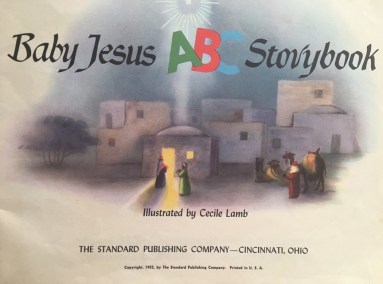
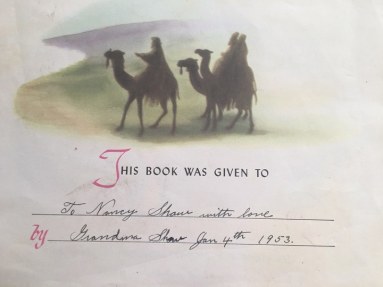
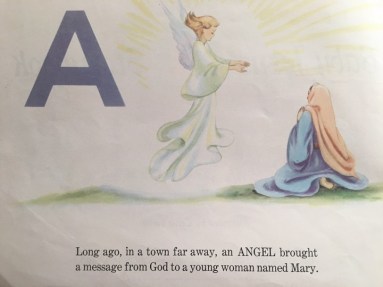
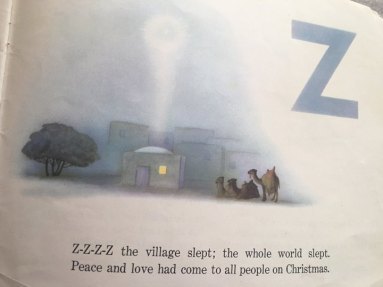
Apparently the book came out in 1952. And now I'm wondering where Granny Shaw found the books she gave me, because they tended to be fairly new ones, and we rarely saw any books where we lived.
Another birthday
I turned six on January 4, 1954. There was no space for it in the Baby Book, but Mom wrote on the last page that I had a party with eight girls. She named the girls and I can remember all except one, who I believe was the younger sister of one of the other girls.
Unfortunately, there's no picture. We still didn't have a flash camera. And maybe no money for films and developing. Just as the last year, there are very few pictures from this year.
We had an angel food cake, which was what I had at all of my birthdays. (Fine with me!) Also sandwiches, ice cream, cookies, Freshie, hats, and balloons. I have no idea what we did at the party. Maybe played some games? January was not a great time for parties in a small town in Manitoba.
Mom and Dad's gift to me was a teddy bear with a music box inside. I vaguely remember it. I think it was black and white. You could wind it up on the back and it played. I think it was either "Twinkle Twinkle Little Star" or "A Teddy Bear's Picnic." Probably the former, although I'm pretty sure either I or a friend had something that played the picnic song.
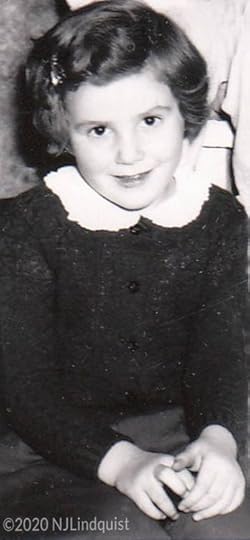
This is me in 1954. I cropped myself out of a picture taken at a friend's 6th birthday party. There were 10 boys and 4 girls at the party, including the boy whose birthday it was. Mom wrote the names on the back.
Our Lives
I've mentioned before that my parents didn't have a lot in common, so I won't go into that again. But they did have a few things. Other than me, that is.
They both liked pets, and we still had Bozo, who turned 16 that year, as well as Tippy, the cat.
They both liked parties and dancing, although I'm not sure they got to do much of that when I was young. I have no memory of a babysitter in Crystal City, although I must have had one. But neither do I have much memory of their having close friends, other than a few of our neighbours.
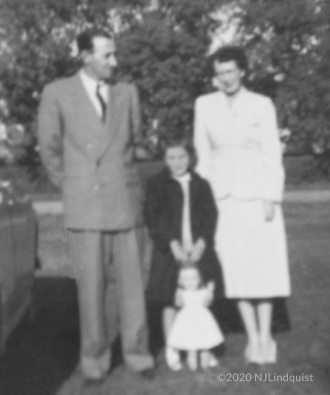
I believe my Aunt Jean took this picture. It's fuzzy, but you get the idea. Mom, Dad, me, and my doll Linda standing beside our car. It was taken some time in 1954. It's one of only a few pictures of all three of us.
They both had an instinctive sense of style and loved to wear nice clothes.
I don’t ever remember seeing my dad looking scruffy or sloppy. He typically wore trousers, a shirt, a tie, and either a sports jacket or a cardigan sweater. He’d have one good suit, usually a three piece one, dark navy or black, or maybe grey. And then a couple of sports jackets with pants to go along. He knew which colours were best on him (winter) and he took pride in looking good. I don't believe he ever owned a pair of jeans after he left the farm although he had a few T-shirts for doing work around the house.
Once he started working in the clothing store, he wore either a suit or a sports jacket and shirt with a tie and nice trousers every day. He also tended to wear a hat as well. I believe it was known as a fedora.
The ritual was the same each day. We had breakfast with my dad—Rice Krispies or Cornflakes, occasionally Sugar Pops or Frosted Flakes, toast and jam—and then he left for work. If it was a nice day and he wasn’t in a hurry, he might walk, but usually he drove even though it wasn’t that far. Mom didn’t drive, so there was no competition for the car.
After Dad left for work, Mom cleaned up the kitchen and did the dishes. Then she went to her room to do her face.
Everyone who knew her was very much aware that looking as nice as possible was crucial to my mom. That included her hair, her clothes, her shoes, her make-up, her perfume, and, of course, her eyebrows.
When I was small, I often went with her to her bedroom and played with a doll or looked at a book while she dressed. Both her hair and her eyebrows drove her crazy.
The truth is, my mother had no eyebrows. Or, if she did have any, the hairs were so very fine and pale that if you were a young child looking up, you couldn’t see them.
That might not be a huge problem for a blonde, but Mom had pale skin and dark brown hair, so not having eyebrows made her look odd, as though her face was incomplete. And for a woman who took pride in her appearance, looking odd was completely out of the question.
As a young child, I sometimes stood and watched in fascination as she drew her eyebrows in with a dark brown pencil. The point had to be sharpened just right. Some eyebrow pencils were better than others—easy to sharpen without breaking, coming in a colour that matches her hair, and going on without smudging so much it looked more like brown crayon scrawls than a natural grouping of individual hairs. Oh yes, they also had to be as cheap as possible.
When she found a pencil she liked, she bought that model until the manufacturer stopped making it or altered it in some way that made it no longer acceptable. Then there’d be a long search for a new one that worked and didn’t cost too much.
Every morning after breakfast, Mom sat down on the fabric-covered stool so she could look into the mirror in the middle of her dresser and gaze at her face. Sometimes she just checked to see if yesterday’s brows still looked okay, and made a few passes with the pencil to touch them up; more often, she started from scratch on a freshly scrubbed face, making small movements so the brows looked as though they were individual hairs, trying to get the two brows to match in height, width, and angle. Sometimes she had to completely scrub one off because they didn't match.
The brows usually lasted for a couple of days with touch-ups, unless she was going to be seeing people other than Dad and me, in which case she usually washed them off, even if they were only done the day before, and started fresh.
Some days the eyebrows went on easily, but more frequently, it took several attempts to get them to match. Occasionally, she washed them both off in frustration.
Over the years, she sometimes said she should just get them tattooed on, but she never really considered it. As if she’d ever go within a mile of a tattoo parlour.
In addition to her eyebrows, Mom's hair drove her crazy. It was fine and straight and she was always going to the hair dresser to get perms and then complaining about them.
Sometimes when Mom was sitting at the dresser putting on her face I’d stand and watch her. And sometimes I’d look past her in the mirror at my own reflection, the thick, naturally wavy hair that was already a huge bone of contention by the time I turned three, and my prominent eyebrows, and think how lucky I was not to have her hair and eyebrows.
Mom would then get dressed—usually in a dress or a skirt and a blouse, but she also wore pants some days. She had a good figure and she was very proud of her shapely legs. She didn't have a lot of clothes, but she chose what to wear based on whether we’d be home all day or whether we'd go out for tea or shopping or have someone over.
Every noon, dad came home for lunch and we ate meat and potatoes, a vegetable and a salad—usually lettuce but sometimes coleslaw. And dessert—our own canned peaches, plums, or cherries. Maybe a Rice Krispies cake. Pie on Saturday and Sunday.
For supper we had something lighter. My favourites were potato pancakes. Dad actually made those. He sometimes made breakfast on Sunday morning, too, so Mom could get ready for church (eyebrows, hair, clothes, and so forth...).
What Mom and I Did All Day...I assume Mom was mostly doing housework and cooking and washing clothes and cleaning up after meals. We might also go shopping for groceries or other needs in the morning.
I mentioned earlier that although I was six, I wasn't in school yet because my birthday was four days into the new year.
I sometimes had to help with little things around the house, like putting my toys away, but mostly I spend my time playing with my dolls and a few other toys or reading my books.
I had every one of my story books memorized long before I could read. In fact, that’s how I learned to read. Since I had them memorized, I began to pick up what each word said, and went from there.
However, I had a drastic shortage of reading materials. There was no library, and I’d never seen a bookstore. The drug store carried a few books or there might be a small rack in the one store in town that carried a few toys, but my parents didn’t have a lot of money, and buying books or toys wasn’t something they did routinely. So until I started school, all I had were the few books we owned—mostly Golden books.
I remember sitting at the table in our dining room, reading my books or working on a puzzle made of 12 blocks that had different fairy tales printed on each side. You could make six different pictures with the blocks. I did each picture over and over and over until the edges of the blocks were all worn.
Aside from that, I had my dolls, a handful of stuffed toys, some colouring books and crayons, a few cut-out paper dolls, and not much else.
I played outside quite a bit, either alone with my bicycle (or sled in the winter) or with other kids in the area.
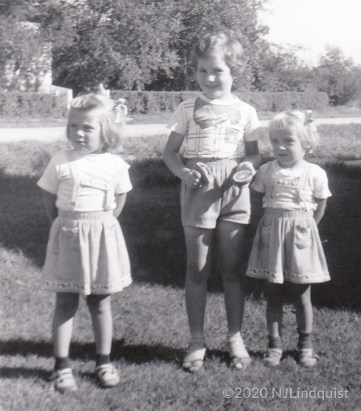
I have no memory of these little girls, but there are several pictures of me with them, one of them on the swing, etc. I assume they lived near us.
Of course, Mom being Mom, she was always telling me not to get dirty. As I got older, she added things like “Be careful," "Don’t fall,” and "Don’t get hurt.”
Looking back, I can see that in some ways I was raised to be afraid. Not that that was my parents’ intention, but my mother in particular was always worried something terrible would happen to me.
I assume it was partly because she was a worrier who tended to see the glass as half full, and partly because I was the only child and she knew there wouldn’t be any more.
I'm certainly not implying that a mother of more than one child doesn’t care about each of her children, but perhaps the intensity isn’t quite the same. As the mother of four sons, myself, I know that there comes a point when you kind of go with the flow. I'm not sure my mother ever really did that.
Anyway, my mother was very protective of me. Even when she was in her 80s, she'd tell me that she smothered me in blankets in the middle of summer when I was a baby—she thought that may have caused my blood system to be a little strange since I’m usually cold if the temperature is below 22 C and and I wilt after 24.
Later, too, as she saw my kids playing in the sand box and rolling on the grass, she wondered aloud if she'd been wrong to always tell me not to get dirty—except her concern was as much my limited selection of clothes and her having to keep them clean as it was the worry that dirt would make me sick.
I still remember learning to skate. They'd bought me skates for my 5th birthday, and continued to buy me more as my feet grew larger. However, learning how to skate while someone is anxiously watching you from the sidelines, admonishing you not to fall, is kind of difficult. I’m not sure it was that or just the fact that I’m not very flexible, but while I did learn to skate a little bit, I was never very good—or very confident. When you aren’t allowed to fail, you usually don’t learn as well.
Dad built me a swing that was attached to the side of our house. Of course, Mom was always reminding me not to go too high and not to scuff my shoes. The swing proved to be an attraction for other kids in our area, too. (More about that later.)
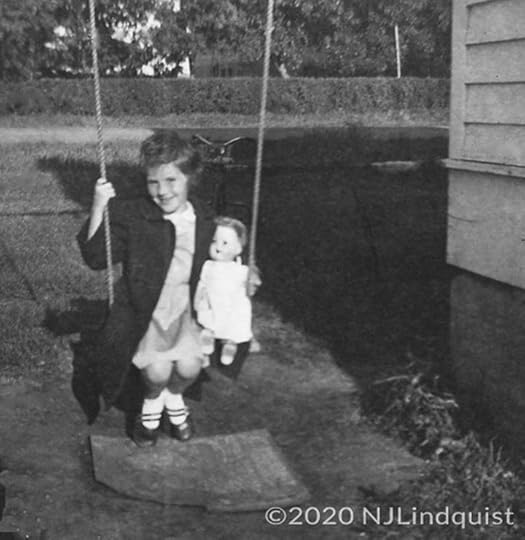
Yep, Linda liked to swing with me. My aunt Jean or my cousin Joan took this photo.
Evening EntertainmentAfter supper, when the dishes were done, Dad might play a game of Snakes and Ladders with me. He also taught me a few card games, like Snap.
The first television stations in Canada had just opened in Montreal and Toronto in 1952, so there was no television in Crystal City until several years later. We also didn’t have a record player.
For entertainment, we’d gather around the radio and listen to whatever programs the CBC carried: the news, of course, but also programs like "The Shadow" (my favourite), "Boston Blackie," "Amos ’n‘ Andy," "Fibber Megee and Molly," "The Saint," "The Jack Benny Show," "Our Miss Brooks," "The Lone Ranger," "Roy Rogers," "Gene Autry," "The Great Gildersleeve," and my mother’s favourite, "Arthur Godfrey Time."
After they put me to bed, I often stayed awake longer than they knew. From the age of three, I’d begun to entertain myself by making up stories. During the day, I used my dolls or other toys; at night, I'd lay in bed making up stories and acting them out with the lights out. Of course, the stories were often triggered by events of the day or by the radio programs I’d listened to.
I got really good at hearing footsteps coming up the stairs and pretending to be asleep when someone (usually my dad) looked in to make sure I was asleep.
What I Knew at SixI double-majored in Psychology and English in university. (A great combination by the way!) One of the things I learned was that there were people who believed that a person's personality is essentially formed by age six. Having observed my own sons and my grandchildren, one of whom has just turned six and another is six and a half as I write this, I think it's very possible. Each of them seemed to have a definite personality by that age, and they also understood a lot about life and the world.
Note: A couple of possibly relevant links below.
https://www.livescience.com/8432-personality-set-life-1st-grade-study-suggests.html
http://www.healthofchildren.com/P/Personality-Development.html
In any case, I'm sitting here trying to visualize who I was at six, and what I understood at that point.
I knew that my Dad was the linchpin in my life. No matter what happened, I knew he loved me and that I could always go to him if I had a problem. But I also knew that there were some problems he couldn't solve. Some things he didn't understand. I knew that my mother had wanted a little girl, and that she had chosen me, but that I wasn't exactly the daughter she'd wanted. We didn't tend to like the same things or even the same people. I also knew that Mom was very sensitive—and easily hurt—and that my dad and I sometimes needed to protect her.I knew that I was more like my dad than my mom in that Dad and I were both quiet people, while Mom seemed to come alive when there were other people around. When we were with other people, I knew that neither my dad nor I had to say much because Mom would do the talking for us. At the same time, she would often embarrass me by pointing out that I hadn't said anything, and of course I would then have no idea what to say. I knew that it was best if I didn’t ask questions my parents couldn’t answer. Not that they would be angry, but that there was no point in making them feel bad if they didn't know.I knew that I didn't always think the same as other people. Sometimes I'd laugh at something that no one else thought was funny. Usually it was because I'd see a connection that no one else saw, or anticipate what was coming next before it was actually said out loud. (Yes, that's still a problem!)I knew that there were certain things I shouldn’t do, such as lying, stealing, getting dirty, or making a big mess. And that there were consequences I wanted to avoid. I knew that books and paper cut-out dolls were the most wonderful things in the world.I knew that I was happiest when I was alone, either reading or making up stories with my paper dolls.I knew that I loved both dogs and cats.I knew that God was always nearby, and that I could talk to God any time. One final thing. I'm not sure I understood it at the time, but looking back, I believe I was very opinionated. I thought abut different things a great deal, and reached conclusions, and it never occurred to me that because I was only six years old my opinions might be of less importance than anyone else's opinions. While I occasionally told one or both of my parents what I thought, I chose to keep the majority of my opinions to myself because I didn't particularly like arguing.. . .
Can You Relate?
What do you remember about yourself at six, and how do you think your family and circumstances affected you?
@media (min-width: 300px){.thrv_symbol_10531 [data-css="tve-u-1656479a734"] { width: 100px; float: none; border: 1px solid rgb(0, 0, 0); box-shadow: rgba(0, 0, 0, 0.4) 0px 8px 12px 0px; margin-left: auto !important; margin-right: auto !important; margin-top: 0px !important; }.thrv_symbol_10531 [data-css="tve-u-1656479a731"] { margin-left: 9px !important; }.thrv_symbol_10531 [data-css="tve-u-1656479a730"] { max-width: 57.4%; }.thrv_symbol_10531 [data-css="tve-u-1656479a733"] { max-width: 42.6%; }.thrv_symbol_10531 [data-css="tve-u-1656479a72f"] { max-width: 820px; float: none; width: 100%; margin-left: auto !important; margin-right: auto !important; }.thrv_symbol_10531 [data-css="tve-u-1656479a72e"] { min-height: 245px; }:not(#tve) .thrv_symbol_10531 [data-css="tve-u-1656479a734"] { width: 252px; }:not(#tve) .thrv_symbol_10531 [data-css="tve-u-1656d159d04"] { font-size: 18px !important; }:not(#tve) .thrv_symbol_10531 [data-css="tve-u-1656d159d06"] { font-size: 18px !important; }:not(#tve) .thrv_symbol_10531 [data-css="tve-u-1656d15d51d"] { max-width: 679px; float: none; width: 100%; margin-left: auto !important; margin-right: auto !important; }:not(#tve) .thrv_symbol_10531 [data-css="tve-u-1656d15d51d"] > .tve-cb { justify-content: center; display: flex; flex-direction: column; }:not(#tve) .thrv_symbol_10531 [data-css="tve-u-1656d16fbe9"] { float: none; width: 100%; margin-left: auto !important; margin-right: auto !important; }:not(#tve) .thrv_symbol_10531 [data-css="tve-u-1656d1795e1"] { font-size: 18px !important; line-height: 0.35em !important; }:not(#tve) .thrv_symbol_10531 [data-css="tve-u-1656d17bf7c"] { line-height: 0.6em !important; color: rgb(113, 30, 30) !important; }}
. . .
LoveChild: Life Lessons from an Ugly Duckling is the story of my struggle to adjust to the life I was given, and my eventual discovery that, not only had I become a swan but, contrary to my perceptions, I had always been one. Though I didn't realize it until many years later, my life was part of a much bigger plan that all made perfect sense.
I'll be blogging my story once a week.
Find links to all these blogs at:
https://www.njlindquist.com/lovechild/

@media (min-width: 300px){.thrv_symbol_10677 [data-css="tve-u-170839f7c3e"] { max-width: 515px; float: none; border: 2px solid rgb(0, 0, 0); margin: 40px auto !important; padding-left: 40px !important; padding-right: 40px !important; }:not(#tve) .thrv_symbol_10677 [data-css="tve-u-170839f7c40"] button { background-image: none !important; background-color: rgb(113, 30, 30) !important; }} Sign Up to Have My New Memoir Posts Sent Directly to Your Inbox
The post LoveChild 34: What I Knew When I Was Six appeared first on N. J. Lindquist.
LoveChild 34: Memories From When I Was Six
“Children are not things to be molded, but are people to be unfolded.”
– Jess Lair, author
Christmas, 1953
Because my birthday comes at the beginning of the year, I tend to think of each year by my age.
Since Christmas comes only a few days before my birthday, and its all part of the holiday season, it gets mashed in with my new age, too.
I'm guessing I got my doll, Debbie (see the last post) for Christmas that year. or maybe a different doll. I'm pretty sure I'd wanted either a garage or a train (I'd seen both in the Eaton's catalogue), but according to my mother little girls didn't play with garages or trains, but with dolls.
Granny Shaw gave me an ABC book for Christmas. It's one of the books I still have.
It goes through the Christmas story using the alphabet. At the back are the words for two Christmas carols, "Away in a Manger" and "What Can I Bring Him?




Apparently the book came out in 1952. And now I'm wondering where Granny Shaw found the books she gave me, because they tended to be fairly new ones, and we rarely saw any books where we lived.
Another birthday
I turned six on January 4, 1954. There was no space for it in the Baby Book, but Mom wrote on the last page that I had a party with eight girls. She named the girls and I can remember all except one, who I believe was the younger sister of one of the other girls.
Unfortunately, there's no picture. We still didn't have a flash camera. And maybe no money for films and developing. Just as the last year, there are very few pictures from this year.
We had an angel food cake, which was what I had at all of my birthdays. (Fine with me!) Also sandwiches, ice cream, cookies, Freshie, hats, and balloons. I have no idea what we did at the party. Maybe played some games? January was not a great time for parties in a small town in Manitoba.
Mom and Dad's gift to me was a teddy bear with a music box inside. I vaguely remember it. I think it was black and white. You could wind it up on the back and it played. I think it was either "Twinkle Twinkle Little Star" or "A Teddy Bear's Picnic." Probably the former, although I'm pretty sure either I or a friend had something that played the picnic song.

This is me in 1954. I cropped myself out of a picture taken at a friend's 6th birthday party. There were 10 boys and 4 girls at the party, including the boy whose birthday it was. Mom wrote the names on the back.
Our Lives
I've mentioned before that my parents didn't have a lot in common, so I won't go into that again. But they did have a few things. Other than me, that is.
They both liked pets, and we still had Bozo, who turned 16 that year, as well as Tippy, the cat.
They both liked parties and dancing, although I'm not sure they got to do much of that when I was young. I have no memory of a babysitter in Crystal City, although I must have had one. But neither do I have much memory of their having close friends, other than a few of our neighbours.

I believe my Aunt Jean took this picture. It's fuzzy, but you get the idea. Mom, Dad, me, and my doll Linda standing beside our car. It was taken some time in 1954. It's one of only a few pictures of all three of us.
They both had an instinctive sense of style and loved to wear nice clothes.
I don’t ever remember seeing my dad looking scruffy or sloppy. He typically wore trousers, a shirt, a tie, and either a sports jacket or a cardigan sweater. He’d have one good suit, usually a three piece one, dark navy or black, or maybe grey. And then a couple of sports jackets with pants to go along. He knew which colours were best on him (winter) and he took pride in looking good. I don't believe he ever owned a pair of jeans after he left the farm although he had a few T-shirts for doing work around the house.
Once he started working in the clothing store, he wore either a suit or a sports jacket and shirt with a tie and nice trousers every day. He also tended to wear a hat as well. I believe it was known as a fedora.
The ritual was the same each day. We had breakfast with my dad—Rice Krispies or Cornflakes, occasionally Sugar Pops or Frosted Flakes, toast and jam—and then he left for work. If it was a nice day and he wasn’t in a hurry, he might walk, but usually he drove even though it wasn’t that far. Mom didn’t drive, so there was no competition for the car.
After Dad left for work, Mom cleaned up the kitchen and did the dishes. Then she went to her room to do her face.
Everyone who knew her was very much aware that looking as nice as possible was crucial to my mom. That included her hair, her clothes, her shoes, her make-up, her perfume, and, of course, her eyebrows.
When I was small, I often went with her to her bedroom and played with a doll or looked at a book while she dressed. Both her hair and her eyebrows drove her crazy.
The truth is, my mother had no eyebrows. Or, if she did have any, the hairs were so very fine and pale that if you were a young child looking up, you couldn’t see them.
That might not be a huge problem for a blonde, but Mom had pale skin and dark brown hair, so not having eyebrows made her look odd, as though her face was incomplete. And for a woman who took pride in her appearance, looking odd was completely out of the question.
As a young child, I sometimes stood and watched in fascination as she drew her eyebrows in with a dark brown pencil. The point had to be sharpened just right. Some eyebrow pencils were better than others—easy to sharpen without breaking, coming in a colour that matches her hair, and going on without smudging so much it looked more like brown crayon scrawls than a natural grouping of individual hairs. Oh yes, they also had to be as cheap as possible.
When she found a pencil she liked, she bought that model until the manufacturer stopped making it or altered it in some way that made it no longer acceptable. Then there’d be a long search for a new one that worked and didn’t cost too much.
Every morning after breakfast, Mom sat down on the fabric-covered stool so she could look into the mirror in the middle of her dresser and gaze at her face. Sometimes she just checked to see if yesterday’s brows still looked okay, and made a few passes with the pencil to touch them up; more often, she started from scratch on a freshly scrubbed face, making small movements so the brows looked as though they were individual hairs, trying to get the two brows to match in height, width, and angle. Sometimes she had to completely scrub one off because they didn't match.
The brows usually lasted for a couple of days with touch-ups, unless she was going to be seeing people other than Dad and me, in which case she usually washed them off, even if they were only done the day before, and started fresh.
Some days the eyebrows went on easily, but more frequently, it took several attempts to get them to match. Occasionally, she washed them both off in frustration.
Over the years, she sometimes said she should just get them tattooed on, but she never really considered it. As if she’d ever go within a mile of a tattoo parlour.
In addition to her eyebrows, Mom's hair drove her crazy. It was fine and straight and she was always going to the hair dresser to get perms and then complaining about them.
Sometimes when Mom was sitting at the dresser putting on her face I’d stand and watch her. And sometimes I’d look past her in the mirror at my own reflection, the thick, naturally wavy hair that was already a huge bone of contention by the time I turned three, and my prominent eyebrows, and think how lucky I was not to have her hair and eyebrows.
Mom would then get dressed—usually in a dress or a skirt and a blouse, but she also wore pants some days. She had a good figure and she was very proud of her shapely legs. She didn't have a lot of clothes, but she chose what to wear based on whether we’d be home all day or whether we'd go out for tea or shopping or have someone over.
Every noon, dad came home for lunch and we ate meat and potatoes, a vegetable and a salad—usually lettuce but sometimes coleslaw. And dessert—our own canned peaches, plums, or cherries. Maybe a Rice Krispies cake. Pie on Saturday and Sunday.
For supper we had something lighter. My favourites were potato pancakes. Dad actually made those. He sometimes made breakfast on Sunday morning, too, so Mom could get ready for church (eyebrows, hair, clothes, and so forth...).
What Mom and I Did All Day...I assume Mom was mostly doing housework and cooking and washing clothes and cleaning up after meals. We might also go shopping for groceries or other needs in the morning.
I mentioned earlier that although I was six, I wasn't in school yet because my birthday was four days into the new year.
I sometimes had to help with little things around the house, like putting my toys away, but mostly I spend my time playing with my dolls and a few other toys or reading my books.
I had every one of my story books memorized long before I could read. In fact, that’s how I learned to read. Since I had them memorized, I began to pick up what each word said, and went from there.
However, I had a drastic shortage of reading materials. There was no library, and I’d never seen a bookstore. The drug store carried a few books or there might be a small rack in the one store in town that carried a few toys, but my parents didn’t have a lot of money, and buying books or toys wasn’t something they did routinely. So until I started school, all I had were the few books we owned—mostly Golden books.
I remember sitting at the table in our dining room, reading my books or working on a puzzle made of 12 blocks that had different fairy tales printed on each side. You could make six different pictures with the blocks. I did each picture over and over and over until the edges of the blocks were all worn.
Aside from that, I had my dolls, a handful of stuffed toys, some colouring books and crayons, a few cut-out paper dolls, and not much else.
I played outside quite a bit, either alone with my bicycle (or sled in the winter) or with other kids in the area.

I have no memory of these little girls, but there are several pictures of me with them, one of them on the swing, etc. I assume they lived near us.
Of course, Mom being Mom, she was always telling me not to get dirty. As I got older, she added things like “Be careful," "Don’t fall,” and "Don’t get hurt.”
Looking back, I can see that in some ways I was raised to be afraid. Not that that was my parents’ intention, but my mother in particular was always worried something terrible would happen to me.
I assume it was partly because she was a worrier who tended to see the glass as half full, and partly because I was the only child and she knew there wouldn’t be any more.
I'm certainly not implying that a mother of more than one child doesn’t care about each of her children, but perhaps the intensity isn’t quite the same. As the mother of four sons, myself, I know that there comes a point when you kind of go with the flow. I'm not sure my mother ever really did that.
Anyway, my mother was very protective of me. Even when she was in her 80s, she'd tell me that she smothered me in blankets in the middle of summer when I was a baby—she thought that may have caused my blood system to be a little strange since I’m usually cold if the temperature is below 22 C and and I wilt after 24.
Later, too, as she saw my kids playing in the sand box and rolling on the grass, she wondered aloud if she'd been wrong to always tell me not to get dirty—except her concern was as much my limited selection of clothes and her having to keep them clean as it was the worry that dirt would make me sick.
I still remember learning to skate. They'd bought me skates for my 5th birthday, and continued to buy me more as my feet grew larger. However, learning how to skate while someone is anxiously watching you from the sidelines, admonishing you not to fall, is kind of difficult. I’m not sure it was that or just the fact that I’m not very flexible, but while I did learn to skate a little bit, I was never very good—or very confident. When you aren’t allowed to fail, you usually don’t learn as well.
Dad built me a swing that was attached to the side of our house. Of course, Mom was always reminding me not to go too high and not to scuff my shoes. The swing proved to be an attraction for other kids in our area, too. (More about that later.)

Yep, Linda liked to swing with me. My aunt Jean or my cousin Joan took this photo.
Evening EntertainmentAfter supper, when the dishes were done, Dad might play a game of Snakes and Ladders with me. He also taught me a few card games, like Snap.
The first television stations in Canada had just opened in Montreal and Toronto in 1952, so there was no television in Crystal City until several years later. We also didn’t have a record player.
For entertainment, we’d gather around the radio and listen to whatever programs the CBC carried: the news, of course, but also programs like "The Shadow" (my favourite), "Boston Blackie," "Amos ’n‘ Andy," "Fibber Megee and Molly," "The Saint," "The Jack Benny Show," "Our Miss Brooks," "The Lone Ranger," "Roy Rogers," "Gene Autry," "The Great Gildersleeve," and my mother’s favourite, "Arthur Godfrey Time."
After they put me to bed, I often stayed awake longer than they knew. From the age of three, I’d begun to entertain myself by making up stories. During the day, I used my dolls or other toys; at night, I'd lay in bed making up stories and acting them out with the lights out. Of course, the stories were often triggered by events of the day or by the radio programs I’d listened to.
I got really good at hearing footsteps coming up the stairs and pretending to be asleep when someone (usually my dad) looked in to make sure I was asleep.
What I Knew at SixI double-majored in Psychology and English in university. (A great combination by the way!) One of the things I learned was that there were people who believed that a person's personality is essentially formed by age six. Having observed my own sons and my grandchildren, one of whom has just turned six and another is six and a half as I write this, I think it's very possible. Each of them seemed to have a definite personality by that age, and they also understood a lot about life and the world.
In any case, I'm sitting here trying to visualize who I was at six, and what I understood at that point.
I knew that my Dad was the linchpin in my life. No matter what happened, I knew he loved me and that I could always go to him if I had a problem. But I also knew that there were some problems he couldn't solve. Some things he didn't understand. I knew that my mother had wanted a little girl, and that she had chosen me, but that I wasn't exactly the daughter she'd wanted. We didn't tend to like the same things or even the same people. I also knew that Mom was very sensitive—and easily hurt—and that my dad and I sometimes needed to protect her.I knew that I was more like my dad than my mom in that Dad and I were both quiet people, while Mom seemed to come alive when there were other people around. When we were with other people, I knew that neither my dad nor I had to say much because Mom would do the talking for us. At the same time, she would often embarrass me by pointing out that I hadn't said anything, and of course I would then have no idea what to say. I knew that it was best if I didn’t ask questions my parents couldn’t answer. Not that they would be angry, but that there was no point in making them feel bad if they didn't know.I knew that I didn't always think the same as other people. Sometimes I'd laugh at something that no one else thought was funny. Usually it was because I'd see a connection that no one else saw, or anticipate what was coming next before it was actually said out loud. (Yes, that's still a problem!)I knew that there were certain things I shouldn’t do, such as lying, stealing, getting dirty, or making a big mess. And that there were consequences I wanted to avoid. I knew that books and paper cut-out dolls were the most wonderful things in the world.I knew that I was happiest when I was alone, either reading or making up stories with my paper dolls.I knew that I loved both dogs and cats.I knew that God was always nearby, and that I could talk to God any time. One final thing. I'm not sure I understood it at the time, but looking back, I believe I was very opinionated. I thought abut different things a great deal, and reached conclusions, and it never occurred to me that because I was only six years old my opinions might be of less importance than anyone else's opinions. While I occasionally told one or both of my parents what I thought, I chose to keep the majority of my opinions to myself because I didn't particularly like arguing.. . .
Can You Relate?
What do you remember about yourself at six, and how do you think your family and circumstances affected you?
@media (min-width: 300px){.thrv_symbol_10531 [data-css="tve-u-1656479a734"] { width: 100px; float: none; border: 1px solid rgb(0, 0, 0); box-shadow: rgba(0, 0, 0, 0.4) 0px 8px 12px 0px; margin-left: auto !important; margin-right: auto !important; margin-top: 0px !important; }.thrv_symbol_10531 [data-css="tve-u-1656479a731"] { margin-left: 9px !important; }.thrv_symbol_10531 [data-css="tve-u-1656479a730"] { max-width: 57.4%; }.thrv_symbol_10531 [data-css="tve-u-1656479a733"] { max-width: 42.6%; }.thrv_symbol_10531 [data-css="tve-u-1656479a72f"] { max-width: 820px; float: none; width: 100%; margin-left: auto !important; margin-right: auto !important; }.thrv_symbol_10531 [data-css="tve-u-1656479a72e"] { min-height: 245px; }:not(#tve) .thrv_symbol_10531 [data-css="tve-u-1656479a734"] { width: 252px; }:not(#tve) .thrv_symbol_10531 [data-css="tve-u-1656d159d04"] { font-size: 18px !important; }:not(#tve) .thrv_symbol_10531 [data-css="tve-u-1656d159d06"] { font-size: 18px !important; }:not(#tve) .thrv_symbol_10531 [data-css="tve-u-1656d15d51d"] { max-width: 679px; float: none; width: 100%; margin-left: auto !important; margin-right: auto !important; }:not(#tve) .thrv_symbol_10531 [data-css="tve-u-1656d15d51d"] > .tve-cb { justify-content: center; display: flex; flex-direction: column; }:not(#tve) .thrv_symbol_10531 [data-css="tve-u-1656d16fbe9"] { float: none; width: 100%; margin-left: auto !important; margin-right: auto !important; }:not(#tve) .thrv_symbol_10531 [data-css="tve-u-1656d1795e1"] { font-size: 18px !important; line-height: 0.35em !important; }:not(#tve) .thrv_symbol_10531 [data-css="tve-u-1656d17bf7c"] { line-height: 0.6em !important; color: rgb(113, 30, 30) !important; }}
. . .
LoveChild: Life Lessons from an Ugly Duckling is the story of my struggle to adjust to the life I was given, and my eventual discovery that, not only had I become a swan but, contrary to my perceptions, I had always been one. Though I didn't realize it until many years later, my life was part of a much bigger plan that all made perfect sense.
I'll be blogging my story once a week.
Find links to all these blogs at:
https://www.njlindquist.com/lovechild/

@media (min-width: 300px){.thrv_symbol_10677 [data-css="tve-u-170839f7c3e"] { max-width: 515px; float: none; border: 2px solid rgb(0, 0, 0); margin: 40px auto !important; padding-left: 40px !important; padding-right: 40px !important; }:not(#tve) .thrv_symbol_10677 [data-css="tve-u-170839f7c40"] button { background-image: none !important; background-color: rgb(113, 30, 30) !important; }} Sign Up to Have My New Memoir Posts Sent Directly to Your Inbox
The post LoveChild 34: Memories From When I Was Six appeared first on N. J. Lindquist.
May 13, 2020
LoveChild 33: A Lesson Learned
“Children are likely to live up to what you believe of them.”
Lady Bird Johnson, Former First Lady of the United States
After the revelation that September (see the previous post), our lives continued exactly as before. I never mentioned it and neither did my parents.
The only other excitement was that I had another trip to the dentist and another cavity filled.
I’m guessing we drove to either Brandon or Winnipeg for a few days around Christmas time, unless we stayed home because I was sick. According to my Baby Book, I was sick for my birthday, which is right after Christmas, so we “celebrated quietly.” Granny Shaw sent me a book, Aunt Margaret and Uncle Albert sent dress hangers, and others sent cards. Mom and Dad gave me a book, some candy and skates.
I find it strange that the Baby Book Mom had offered a place to write down presents for birthdays but not for Christmas since I'm pretty sure my Christmas presents were more interesting. Of course, since my birthday came so closely to Christmas, some of my presents were for both.
My dolls
I'm not sure when, but somewhere between four and six—probably at Christmas—my parents gave me two dolls. One was Linda and the other was Debbie. For some reason, Debbie appears in very few pictures, but Linda is in a number of them. You might have noticed her in my last post. The two dolls were about the same size, but very different in that Debbie was soft and cuddly, and Linda was hard and not even remotely cuddly. But Linda could “walk.”
This picture was taken a few years later, but you can see both Linda and Debbie in it.
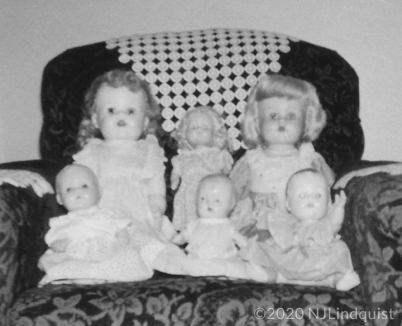
Linda is at the back on your left and Debbie is at the back on your right. This photo is from 1958.
Linda was one of a line of dolls called Saucy Walkers and apparently they were all the rage back in the early 1950s. I can find numerous pictures of them on the Internet, but I can't find Debbie/Debby. I'm quite sure that was her name.
I have no idea what the names of the other dolls in this photo were, but Mom said I had a Judy, a Donna and a Mary. When I was nine or ten, I got a Tiny Tears doll which might be in the front row, but I'll tell you more about it later.
Anyway, apparently I still played with my dolls a lot. But I no longer carried them around completely- or half-undressed. Although shoes were hard to come by.
I loved playing in the snow
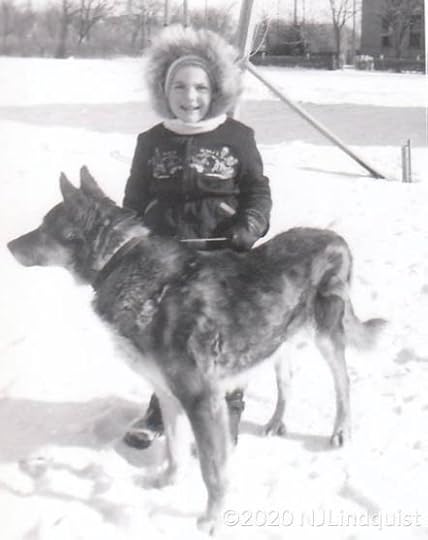
Me with my best friend, Bozo.
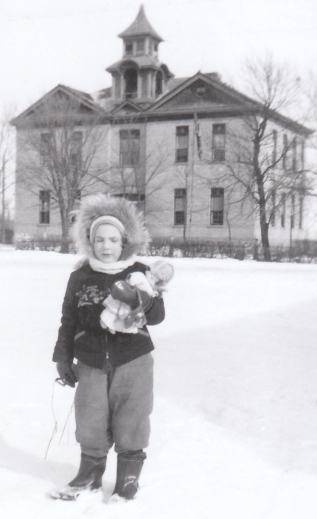
One of my smaller dolls got to go out in the snow. The cord I'm holding onto is from my sled. There's another picture of me with the sled, but since my eyes are shut in it, too, I didn't bother posting it. Hmm. I wonder if the sun was too bright that day?
We had a very large yard and there were some slanted places in it (not hills, but...) so I could sled and take my dolls for rides. My dad would pull me in the sled sometimes, and I might have had Bozo pull the sled, too.
We got a new car
A salesman somewhere had convinced my dad that it was best to change cars every couple of years instead of keeping one until it was old and ready for the junkyard.
On the back of this picture, which was taken in the fall of 1953, Mom wrote that this car was a 1949 or 1950 Chevrolet Fleetline Deluxe 2-door.
Since it’s a very light colour, I’m going to guess it was yellow/gold, as evidenced by this link. My dad was never one for subtle colours—at least not for his cars. They do talk about men and their cars. I really think that for him it was some kind of status symbol.
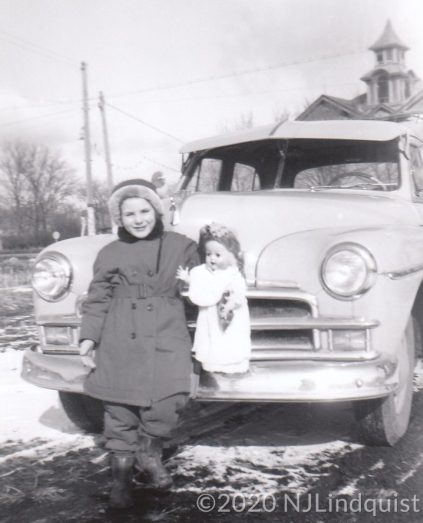
Five-year-old me with my doll Linda and our new car.
Most of 1953 is missing
The above pictures and the one of me with my sled are the only ones I can find from the entire year. Seriously. I have no idea what happened. Were we short of cash, so there was no money for developing pictures? Too busy? Just didn't think of it? Had some films go astray? No idea. But I have to go by memories, not pictures.
My most vivid memory from the year when I was five
In those days, in a small prairie town, a child of five was allowed to go outside without their parents worrying. I often walked the couple of blocks to my dad’s store. And I sometimes watched him as he sold things and used his cash register. I found the cash register fascinating and he would let me use it and even make changes sometimes if the customer was a friend.
I also noticed that sometimes people asked my Dad to hold something for them and they'd pay a little each week until it was paid for. But sometimes people needed their purchase right away so they asked my dad to "charge" some or all of the cost. Usually, they said they didn't have enough money, but would get paid later in the month. My dad would write down the amount they owned in a little ivory-coloured pad that had a piece of carbon paper in it, so that he would have the original record and the buyer would have a copy. He did that when they bought and paid for something, too, but the ones that weren't paid in full went in a special folder.
I must have thought that was a good system, because one day in the summer, I went to the hotel, asked for a chocolate bar, and charged it to my dad.
The hotel was across the main street, kitty corner from our house, so I went past it all the time (although usually on the other side of the street). Sometimes we went to the hotel's restaurant for supper when it was a special occasion, like Mom's birthday.
In the lobby, they had a counter with glass on the front, and inside the glass was a display of chocolate bars and other candy. Back then, the bars came in small and large, the small being five cents, and the large ten cents. My favourite kinds were Oh Henry! and Crispy Crunch, which was also my mother's favourite.
I'm not sure which bar I chose that day, but after the clerk put it on the counter and asked for my money, I told her to charge it to my dad and he would pay it. I think the clerk was surprised, and I vaguely recall a conversation she had with someone else, but I went home with the chocolate bar.
However, when dad came home for supper, he didn't go to the kitchen and sit down at the table. Instead, he saw me and said, "What did you do with the chocolate bar?"
Turns out someone from the hotel had phoned him to let him know of my purchase.
Fortunately, I hadn’t eaten it. Likely because I knew I shouldn’t have done it.
I went to my room and got it.
"Come on. We're taking it back."
I really, really didn't want to take it back. Not so much because I wanted to eat the bar, but because I was embarrassed because he thought I'd done something wrong.
I tried to make excuses, but he wasn't buying any of them.
He explained that when someone charged something at his store, it was because they really needed it and they really didn't have the money. He had to trust them to pay it later. He said that most people were trustworthy, but now and then someone didn't come back and pay and that made him sad.
But for me to go and get something I really didn't need and then charge it to him was like stealing. "You can't go and buy something and charge it to to someone else."
Nobody yelled or spanked me or anything, but my dad made me come with him, and we walked over to the hotel, where I quietly apologized to the clerk and watched as my dad gave back the chocolate bar. Then we went home and had supper.
Nothing was ever said about it again, although at bedtime that night, Mom did ask me what I'd been thinking. I didn't know what to say. It just seemed a good idea at the time.
However, it was a lesson I never forgot. Don't steal because that will make someone else sad, and don't do things behind my parents back because when they find out (and they will) they won't ignore it.
Looking back, I'm kind of impressed that it occurred to me to charge the bar. I mean, that was some nice lateral thinking. I'm also impressed that my dad handled it the way he did, making me go with him to return the bar. It would have been so easy for him to pay for it or take it back himself, or even eat it himself. But he felt he needed to make sure I knew not to do anything like that again, and that a moment's embarrassment was worth the lesson. What I learned was that my dad expected me to be a good, trustworthy person, and I wanted to live up to his expectation.
. . .
Can You Relate?
The quotation at the top of the page says that "Children are likely to live up to what you believe of them."
Were you fortunate enough to have at least one parent who expected the best from you, or did you have to struggle against parental expectations?
@media (min-width: 300px){.thrv_symbol_10531 [data-css="tve-u-1656479a734"] { width: 100px; float: none; border: 1px solid rgb(0, 0, 0); box-shadow: rgba(0, 0, 0, 0.4) 0px 8px 12px 0px; margin-left: auto !important; margin-right: auto !important; margin-top: 0px !important; }.thrv_symbol_10531 [data-css="tve-u-1656479a731"] { margin-left: 9px !important; }.thrv_symbol_10531 [data-css="tve-u-1656479a730"] { max-width: 57.4%; }.thrv_symbol_10531 [data-css="tve-u-1656479a733"] { max-width: 42.6%; }.thrv_symbol_10531 [data-css="tve-u-1656479a72f"] { max-width: 820px; float: none; width: 100%; margin-left: auto !important; margin-right: auto !important; }.thrv_symbol_10531 [data-css="tve-u-1656479a72e"] { min-height: 245px; }:not(#tve) .thrv_symbol_10531 [data-css="tve-u-1656479a734"] { width: 252px; }:not(#tve) .thrv_symbol_10531 [data-css="tve-u-1656d159d04"] { font-size: 18px !important; }:not(#tve) .thrv_symbol_10531 [data-css="tve-u-1656d159d06"] { font-size: 18px !important; }:not(#tve) .thrv_symbol_10531 [data-css="tve-u-1656d15d51d"] { max-width: 679px; float: none; width: 100%; margin-left: auto !important; margin-right: auto !important; }:not(#tve) .thrv_symbol_10531 [data-css="tve-u-1656d15d51d"] > .tve-cb { justify-content: center; display: flex; flex-direction: column; }:not(#tve) .thrv_symbol_10531 [data-css="tve-u-1656d16fbe9"] { float: none; width: 100%; margin-left: auto !important; margin-right: auto !important; }:not(#tve) .thrv_symbol_10531 [data-css="tve-u-1656d1795e1"] { font-size: 18px !important; line-height: 0.35em !important; }:not(#tve) .thrv_symbol_10531 [data-css="tve-u-1656d17bf7c"] { line-height: 0.6em !important; color: rgb(113, 30, 30) !important; }}
. . .
LoveChild: Life Lessons from an Ugly Duckling is the story of my struggle to adjust to the life I was given, and my eventual discovery that, not only had I become a swan but, contrary to my perceptions, I had always been one. Though I didn't realize it until many years later, my life was part of a much bigger plan that all made perfect sense.
I'll be blogging my story once a week.
Find links to all these blogs at:
https://www.njlindquist.com/lovechild/

@media (min-width: 300px){.thrv_symbol_10677 [data-css="tve-u-170839f7c3e"] { max-width: 515px; float: none; border: 2px solid rgb(0, 0, 0); margin: 40px auto !important; padding-left: 40px !important; padding-right: 40px !important; }:not(#tve) .thrv_symbol_10677 [data-css="tve-u-170839f7c40"] button { background-image: none !important; background-color: rgb(113, 30, 30) !important; }} Sign Up to Have My New Memoir Posts Sent Directly to Your Inbox
The post LoveChild 33: A Lesson Learned appeared first on N. J. Lindquist.

